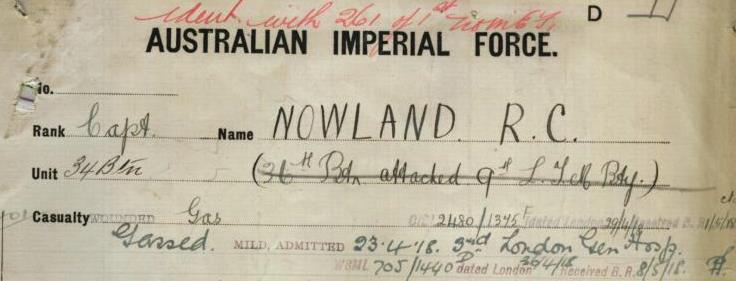A.N.& E.F. - 36th BATTALION - 34th BATTALION - 9th Light Trench Mortar Battery AIF
Captain: 261 Raymond Clare NOWLAND. M.I.D
Born: 4th August 1894. Ryde, New South Wales, Australia. Birth Cert:30177/1894.
Married: 22nd December 1922. Queensland, Australia.
Wife: Margaret Eupham Duguid nee: Douglas. (1898-1987)
Died: 1973. Queensland, Australia.
Father: Edward Joseph B. C. Nowland. (1857-1939)
Mother: Louisa Maria Nowland. nee: Maguire. (18..-1926)
INFORMATION
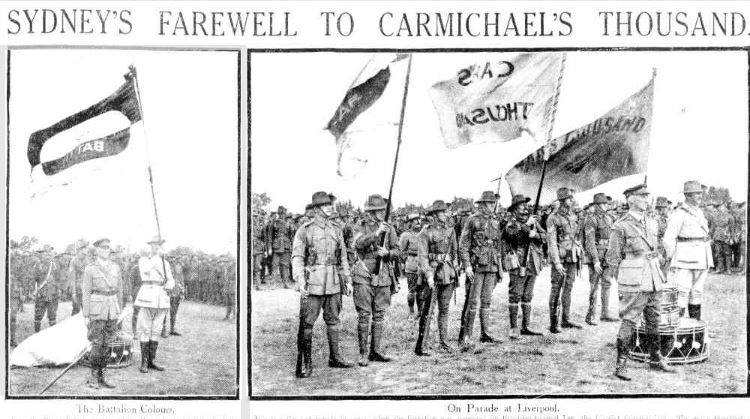
7th June 1917.
THE BATTLE OF MESSINES
The 3rd Australian Divisions first major offensive was at Messines Ridge on the 7th June 1917. The Australian 3rd Division was a part of the II Anzac Corps which was allotted to the first assault. The 25th New Zealand, 3rd Australian Division with the 4th Australian Division in reserve. The 4th Division were battle hardened troops who had fought many major battles.The 3rd Australian Division were having problems getting to the "jump off" point. The day before the 9th and 10th Infantry Brigades were bombarded by German Gas-Shells around Hill 63 and Ploegsteert Wood. Many of the Aussies were not wearing gas masks, but despite this they pressed on even though they received 500 casualties.
They made it to the "jump off" point but only just with some of the men from the 9th and 10th going straight over the top without stopping. The mines went up and the attack commenced behind a protective barrage. The II Anzac Corps were attacking on the right with their objective being the southern shoulder of the ridge which included Messines, the Dover and St Yves areas as far south to the east of Ploegsteert Wood.
Major General Sir John MONASH's 3rd Division had to contend with a tricky 3 mile approach out of Ploegsteert Wood and after the German gas attack, but they were not deterred. The 9th Infantry Brigade under Brigadier General: Alexander JOBSON and the 10th Infantry Brigade under Brigadier General W R NICHOLL had just made the jumping off point but some of the men did not stop, going straight into the assault from the approach march.
Their objective lay between St Yves and the Douve. The mines at Trench 127 and Trench 12 at Factory Farm were laid to aid this task. The explosions erupted a few seconds before zero hour and created craters of 200 feet in diameter, completely obliterating the German defense line as the 9th and 10th Infantry Brigades went over the top. The mine crates forced the 9th and 10th Brigades to veer to the left and right which caused some confusion with the main assault. It is testimony to the quality of training that every man knew the ground, tasks and objectives so well.
Private: 1804 John CARROLL 33rd Battalion, rushed the enemy's trench and bayoneted four of the German occupants. He then noticed a comrade in difficulties and went to his assistance, killing another German. He then attacked single handed a German Machine Gun Team, killing all three of them and capturing the gun. He later rescued two of his comrades who had been buried alive by German Shell Fire, and in spite of heavy shelling and machine gun fire he dug them out alive and saved them from certain death. John was awarded the Victoria Cross.
The German forward zone was completely engulfed and taken by the main assault. The two supporting battalions of each brigade then passed the leading battalion to continue the advance. The men were constantly re-supplied and the ridge was taken. There were many German prisoners taken during the offensive. The 3rd Division was well ahead with the 9th Infantry Brigade pushing on beyond Grey Farm, and on the right the 10th Infantry Brigade were veering left towards Septieme Barn north of Douve.
The German resistance was heavy but was generally brushed aside by tanks and artillery before the infantry had to become too involved.The 4th Bavarian Divisions Artillery had made little impact, but as the day wore on the 3rd Division and later the 4th Australian Division received many casualties from German artillery. (70% of all casualties during WW1 were from artillery).
By 9:00am nearly 6 hours after the assault began the Germans were in dissaray, but there was a major problem as the Australians received less casualties as anticipated and when ordered to dig into the ridge they had so many men, that some could not find shelter. the 35th battalion were dug in around Seaforth Farm.
The second phase of the operation was to take the Oosttaverne Line. The 3rd Australian Division would now be in reserve with the 4th Division attacking. The 9th Infantry Brigade (33-34-35-36Bn) were near Thatched Cottage facing Warneton. The river Lys was to their right and the Ploegsteert Wood was now behind them.
Once their objectives were taken the troops consolidated. A barrage to stop and counter attack was shortened and caught three battalions which had to retire. By 9:00 pm this part of the Oosttaverne Line was abandoned. At 10:45 pm General: Alexander John GODLEY ordered the 3rd and 4th Divisions to retake it. This they did by the early hours of the 8th of June.
The Battle for Messines Ridge during May-June 1917 saw 35 officers and 1,631 other ranks loose their lives.
9th Infantry Brigade Casualties.
| 33rd Battalion. AIF | 8 Officers | 382 Other ranks |
| 34th Battalion. AIF | 10 Officers | 378 Other ranks |
| 35th Battalion. AIF | 5 Officers | 431 Other ranks |
| 36th Battalion. AIF | 9 Officers | 421 Other ranks |
| 9th Machine Gun Company. AIF | 2 Officer | 17 Other ranks |
| 9th Light Trench Mortar Battery. | 1 Officer | 2 Other ranks |

FIELD DRESSING STATION, MESSINES 7th June 1917.
| Rank | Captain |
|---|---|
| Unit | 9th LTM Bty (36th Bn) |
| Service | Australian Imperial Force |
| Conflict/Operation | First World War, 1914-1918 |
| Award | Mention in despatches |
| Commonwealth of Australia Gazette | 24 October 1918 on page 2056 at position 181 |
| London Gazette | 28 May 1918 on page 6202 at position 68 |
Raymond was Wounded in Action on the 18th April and was treated by the 9th Australian Field Ambulance and was evacuated to the 8th General Hospital at Rouen suffering from Gas Poisoning before he was invalided to England on the 22nd of April where he was admitted to the 3rd London General Hospital. Whilst in England, Raymond was transferred from the 36th Battalion when they were disbanded on the 30th April 1918 before he was and after he was discharged from Hospital he proceeded to France on the 9th of August 1918 a few moths before the Armistice.
11th November 1918.
ARMISTICE SIGNED
We could now tell by the news in the papers that the war was practically over although we (The Third Division) was told to hold ourselves in readiness to proceed to the line again – the 1st, 4th, and 5th Australian Divisions being already on their way back to the line. On Monday 11th November 1918 (the day the Armistice was signed) we marched to Alleray for a hot steam bath and on passing through Airaides found all the houses decorated with tri colours and the church bells pealing and the Frenchies running about like madmen. We wondered what was wrong and halted in the main street for a rest. The Captain then told us (he had interviewed the Mayor who had received a telegram saying that the Armistice was to be signed) that the Armistice was to be signed at 11 a.m. that morning – it was then about 10 a.m. We gave three cheers and could scarcely realize that the war was over. When we arrived back at Warlus the news had already reached there and the town was decorated &c. Next day we had a holiday from drill to celebrate Peace. The bells of the old French church chimed day and night for several days. Most of us attended the Victory Mass at the Roman Catholic Church and we also had a great Thanksgiving service out on the parade ground. Some of the men broke camp and went to the neighbouring cities and some got as far as Paris. Many were "pinched" and put in clink (gaol) as they had no leave passes – others were caught and sent back to the Battalion.
Raymond was granter leave to London from the 29th January 1919 to the 29th April 1919 before he was to Return to Australia.
Raymond returned to Australia where his appointment with the AIF was terminated on the 19th December 1919 and he later enlisted with the AMF and was transferred to 5/53rd Infantry Regiment and to be Captain on the 16th September 1920. He was transferred to the 36th Battalion (New organisation) on the 31st March 1921. Raymond was placed on the unattached list on the 1st November 1921 before he was transferred to the 9th Battalion on the 1st March 1922. He was again placed on the unattached list on the 1st July 1922 where he remained until the 1st July 1927 when he was placed on the Reserve Officers List.
Family Information
Raymond was a single 20 year old Draughsman from 70 Orphington Street, Ashfield via Sydney, N.S.W. upon his enlistment with the AIF.
Military Records

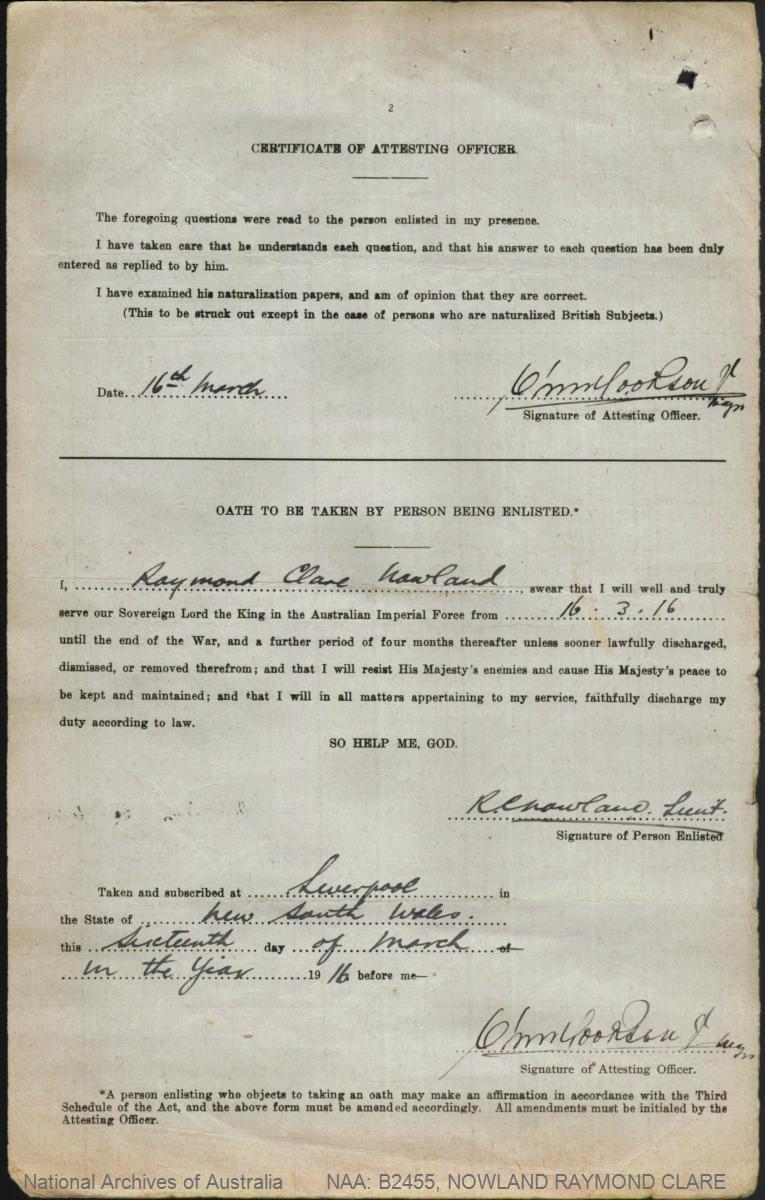
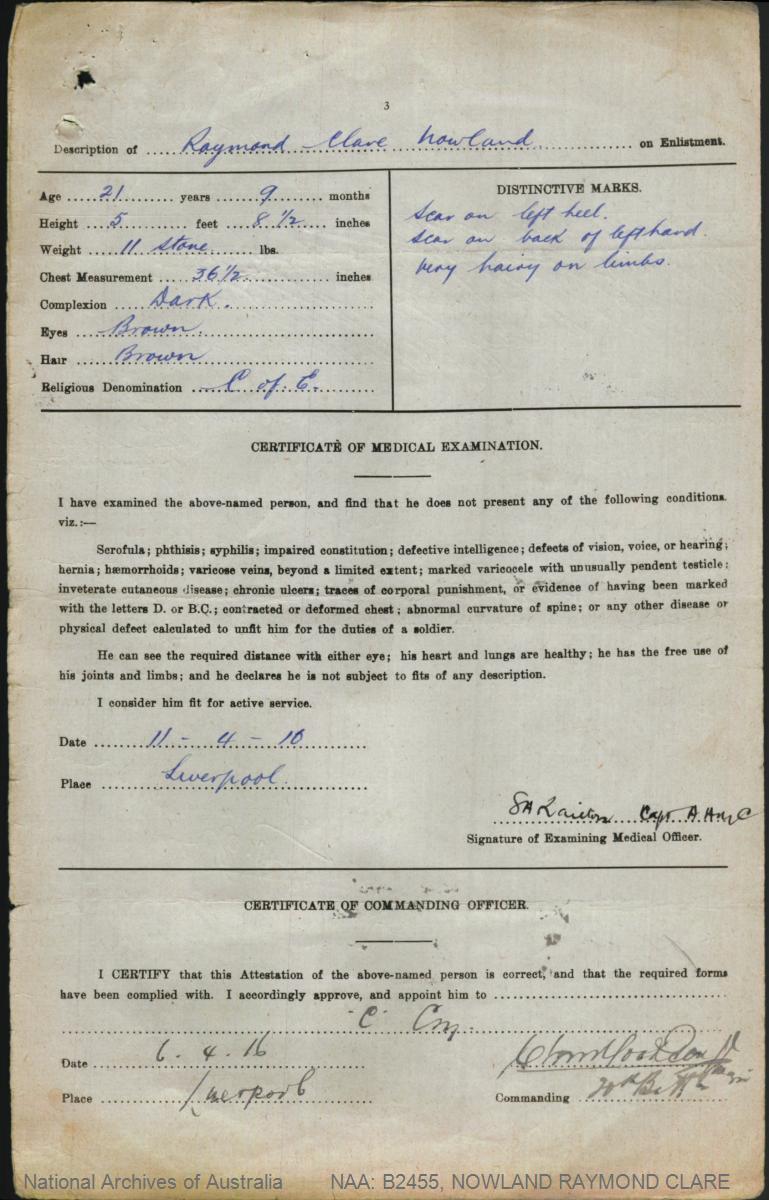
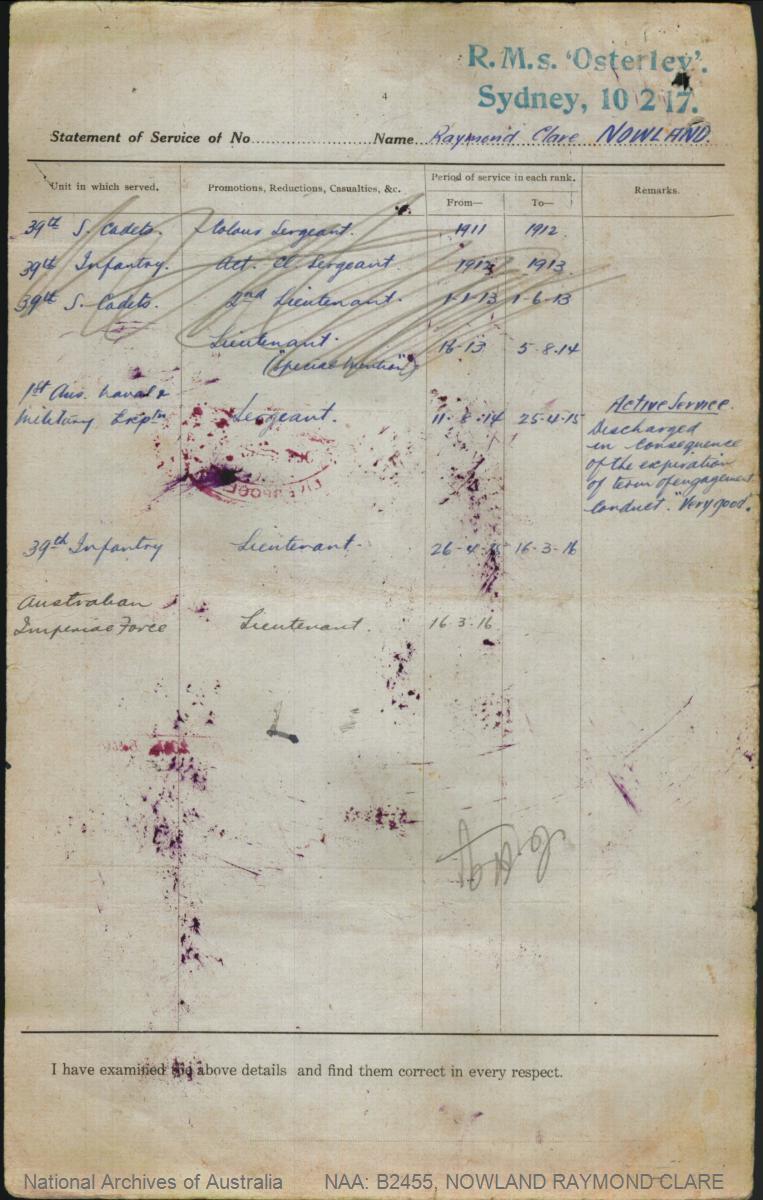
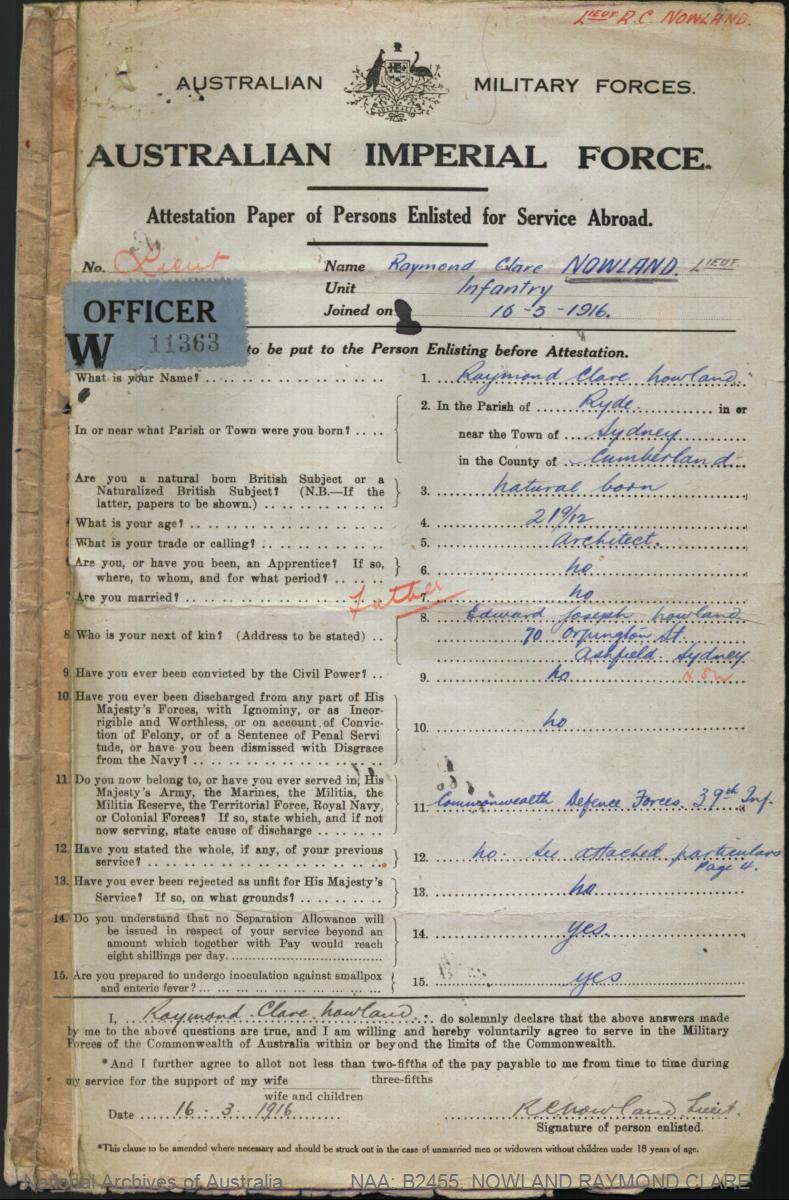
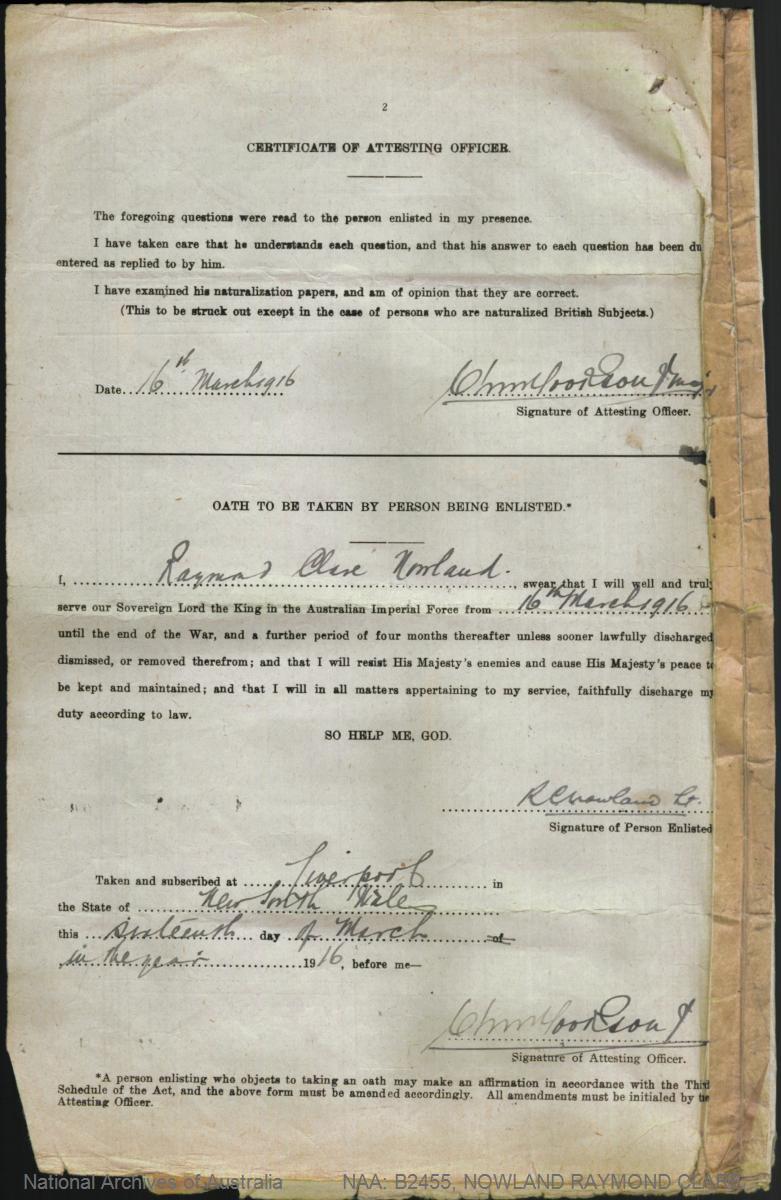
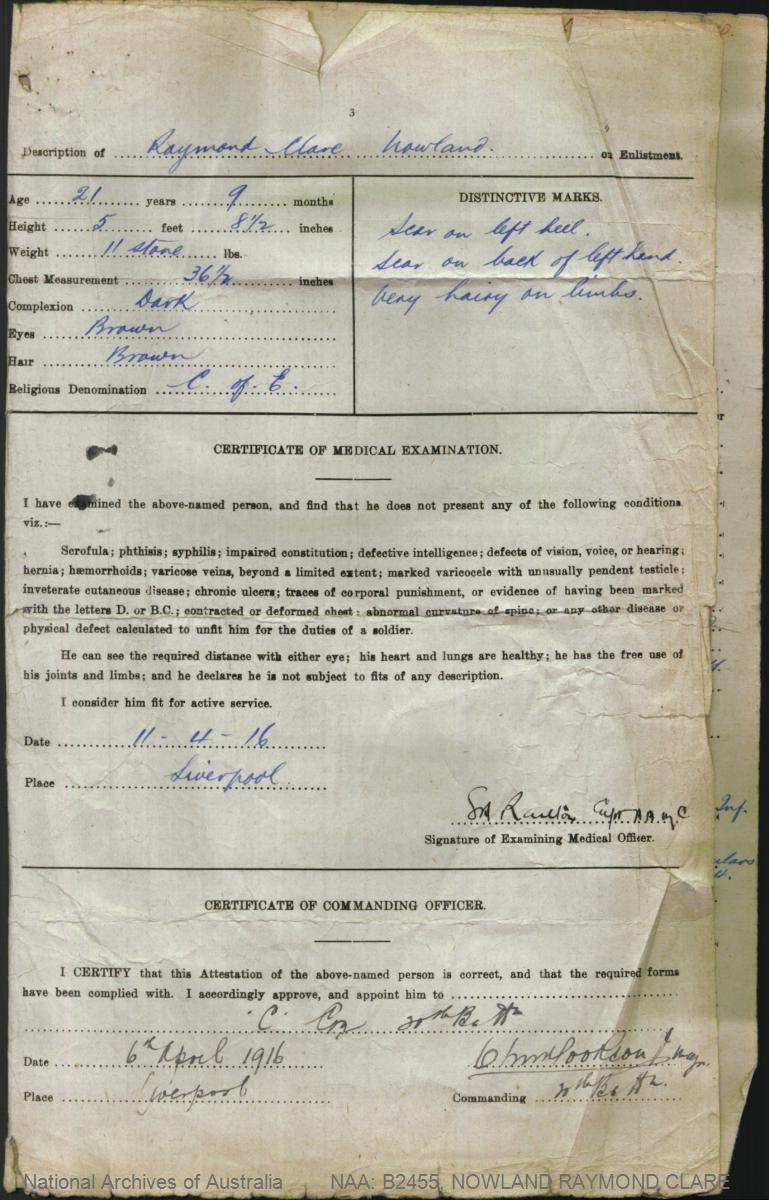

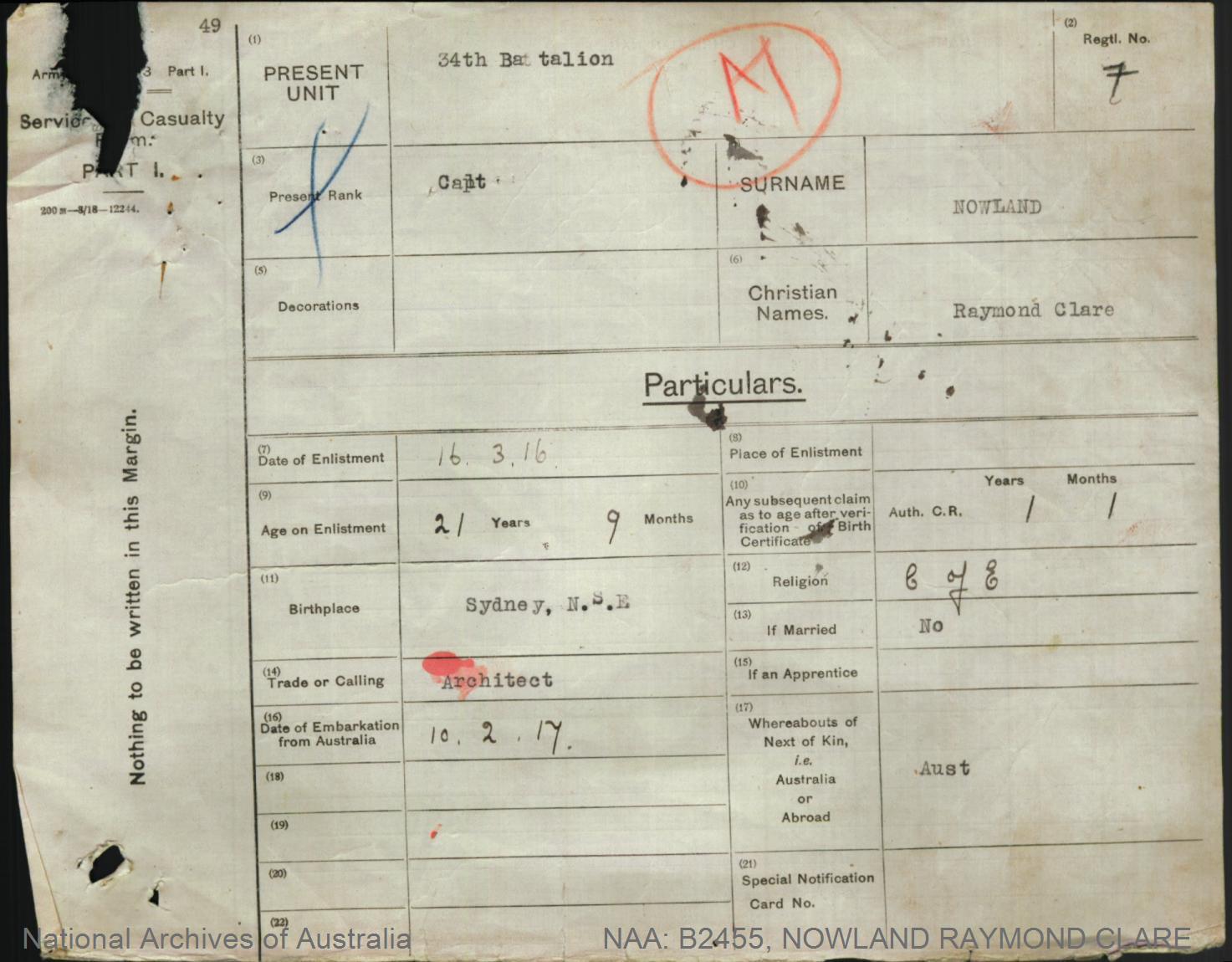

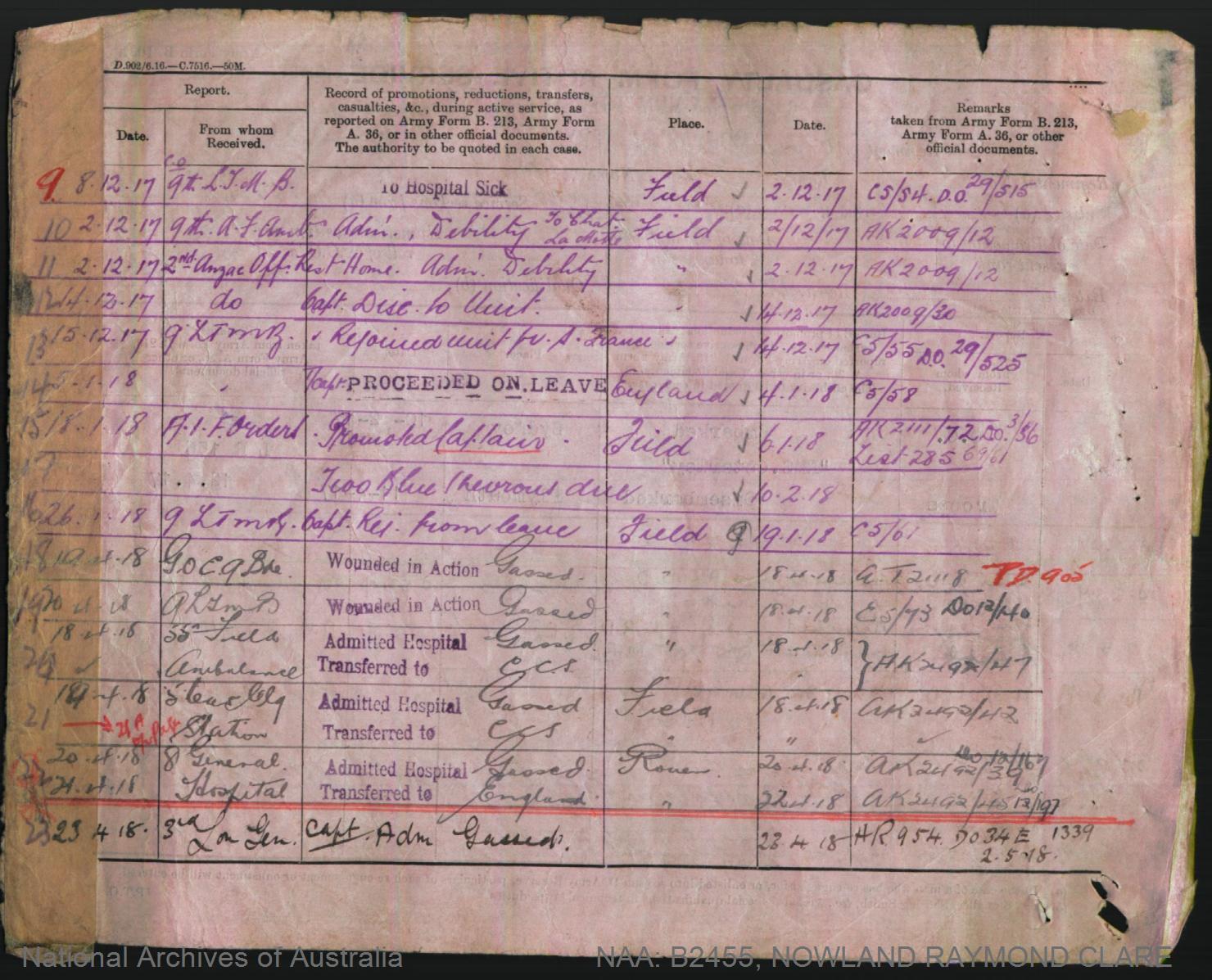
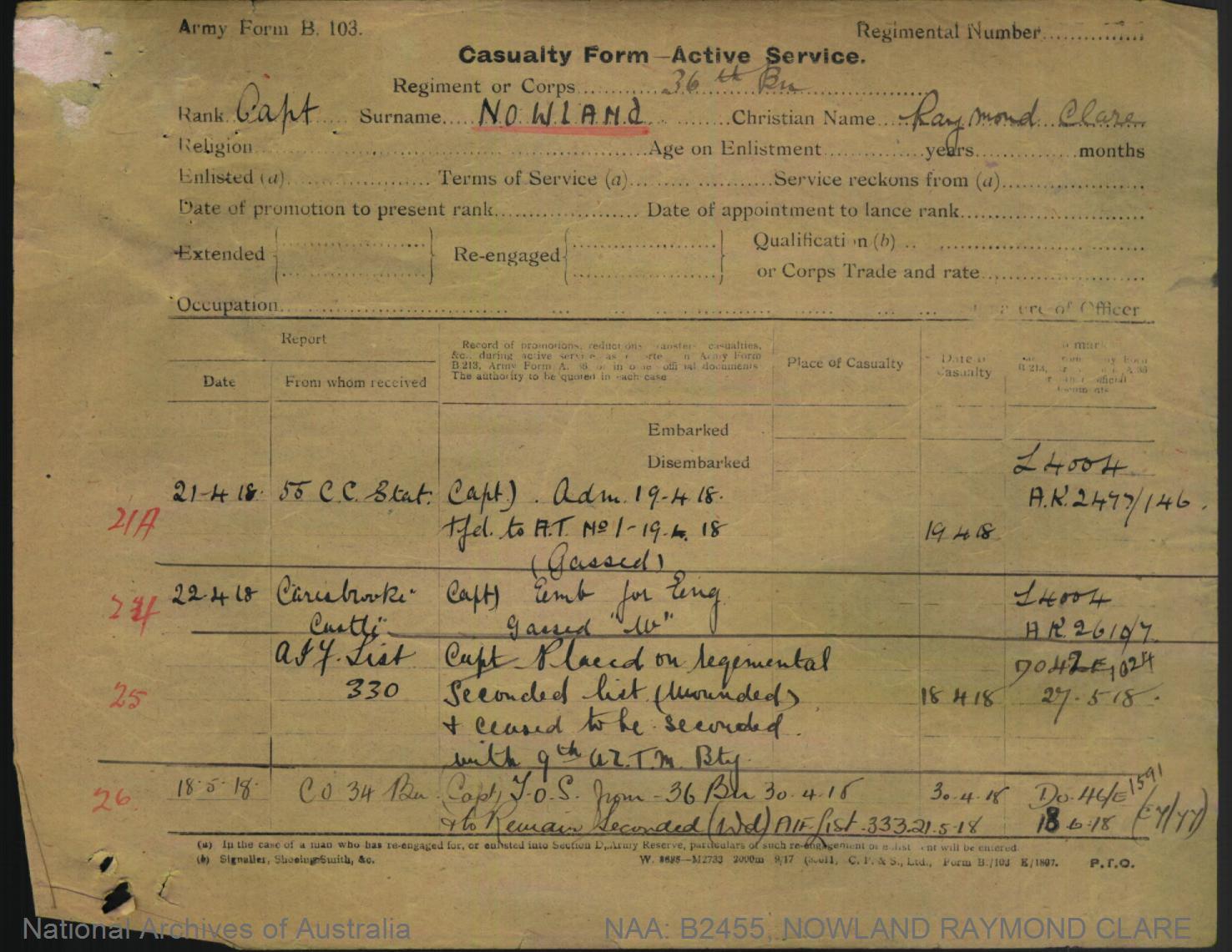

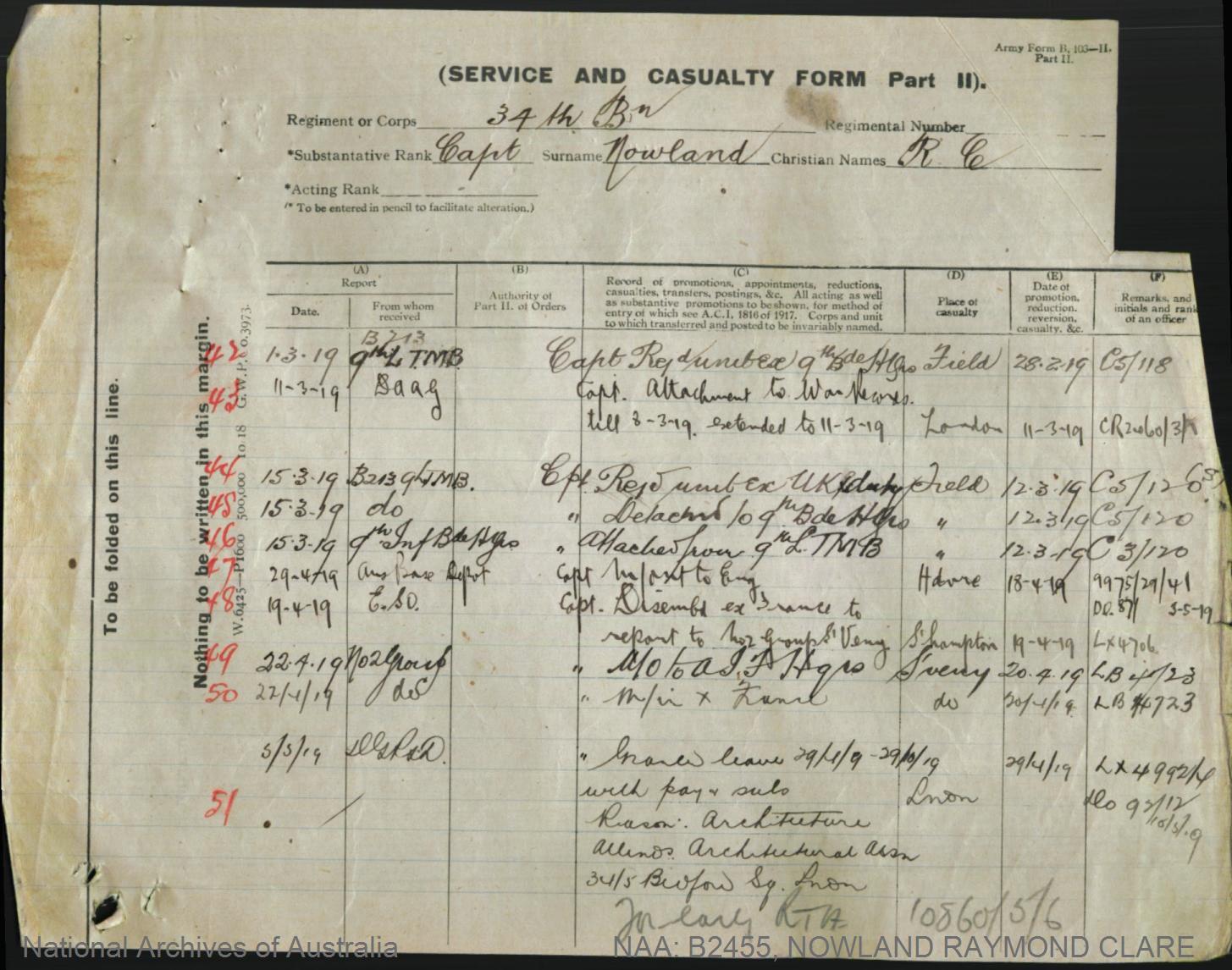
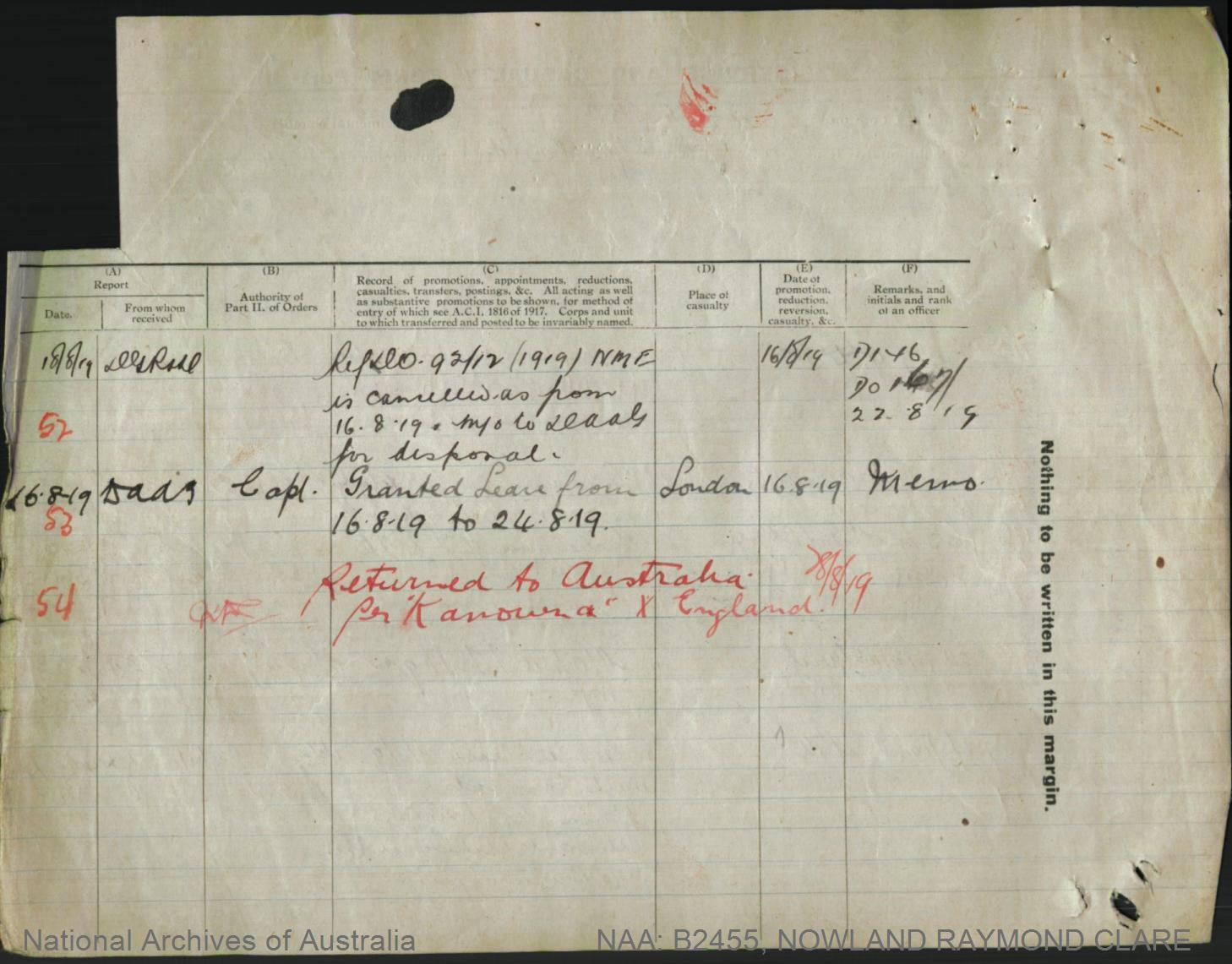
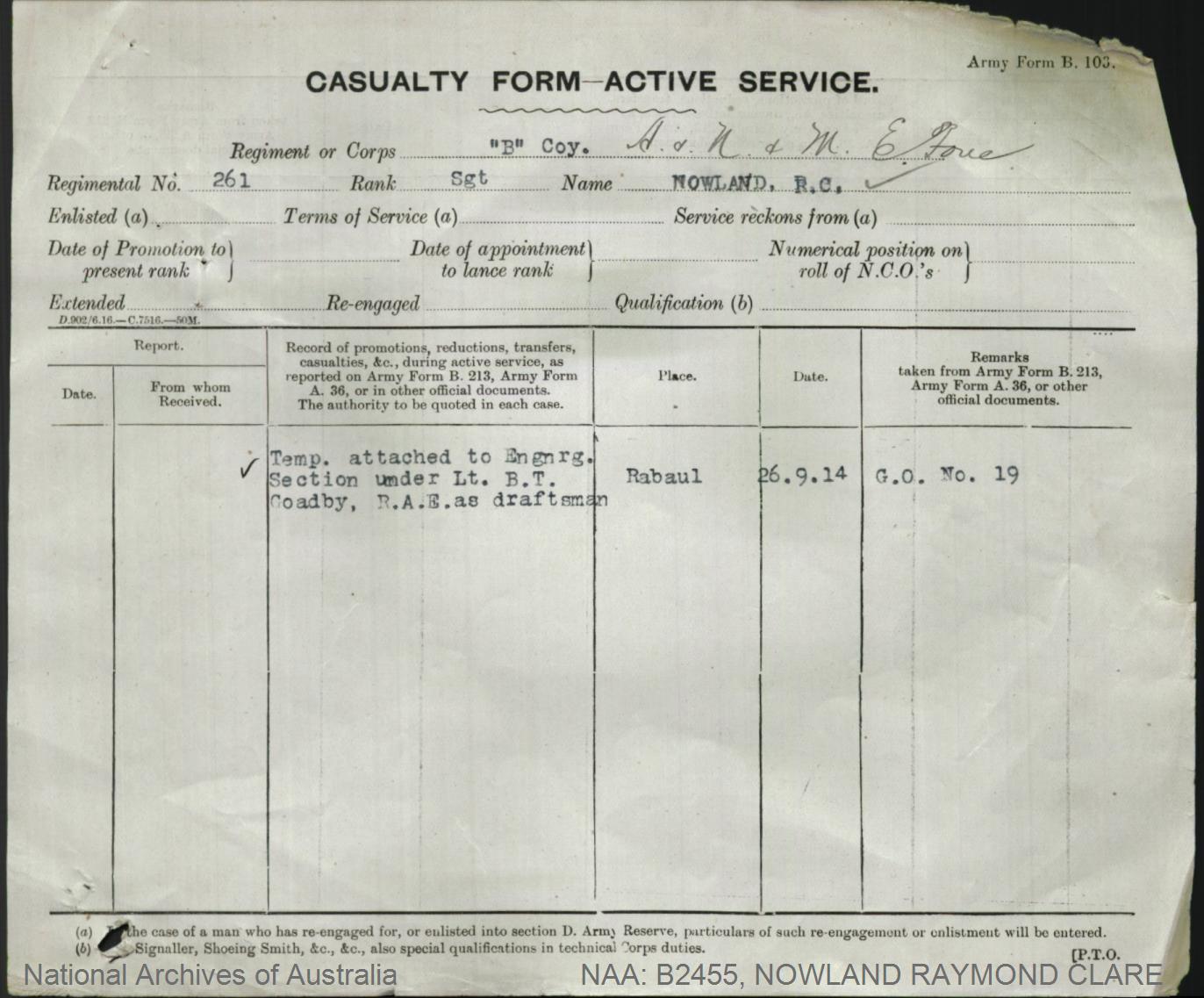
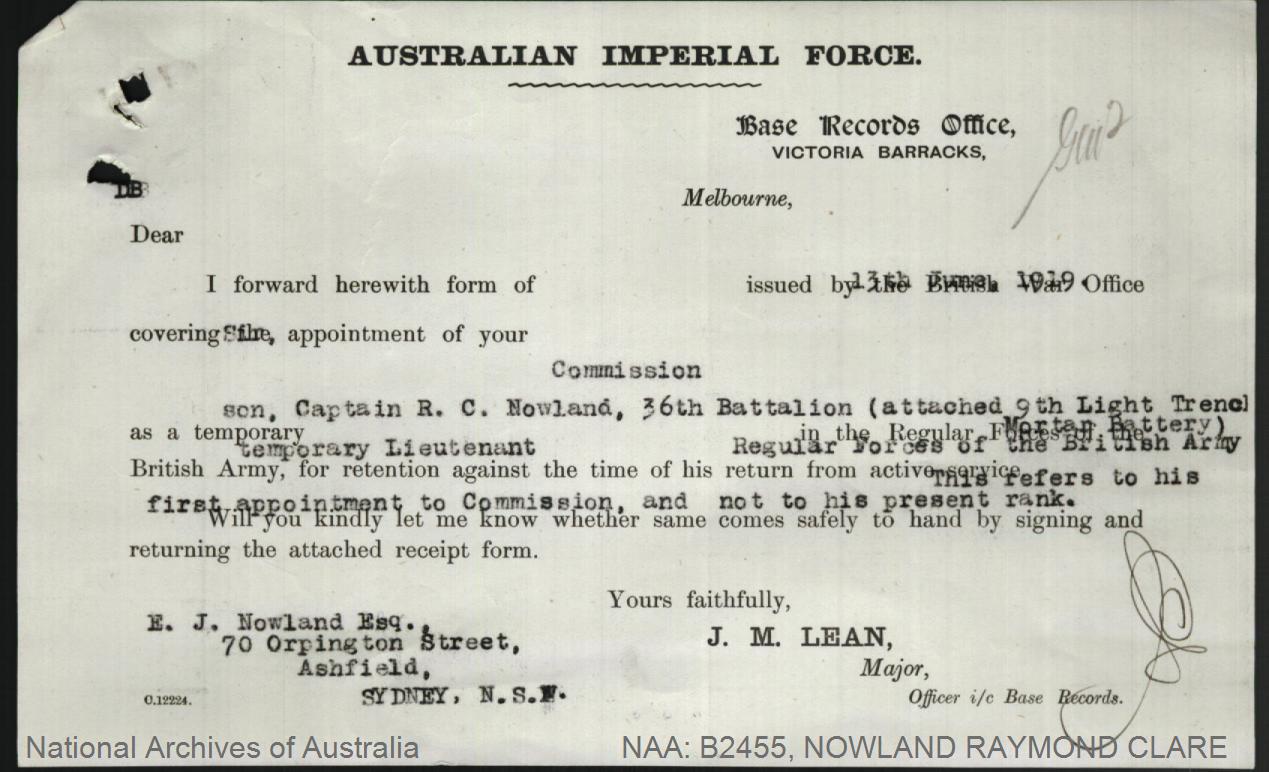
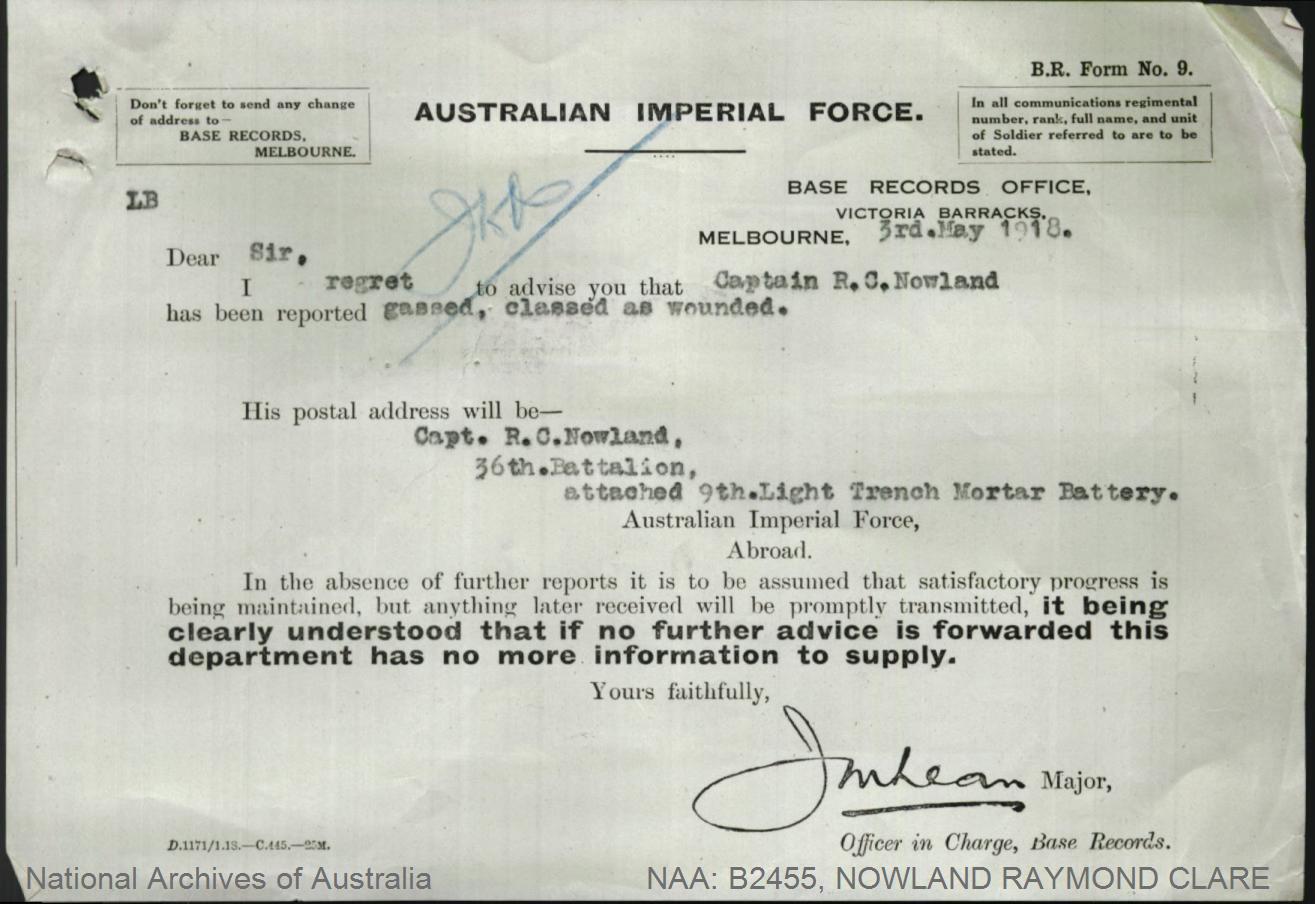
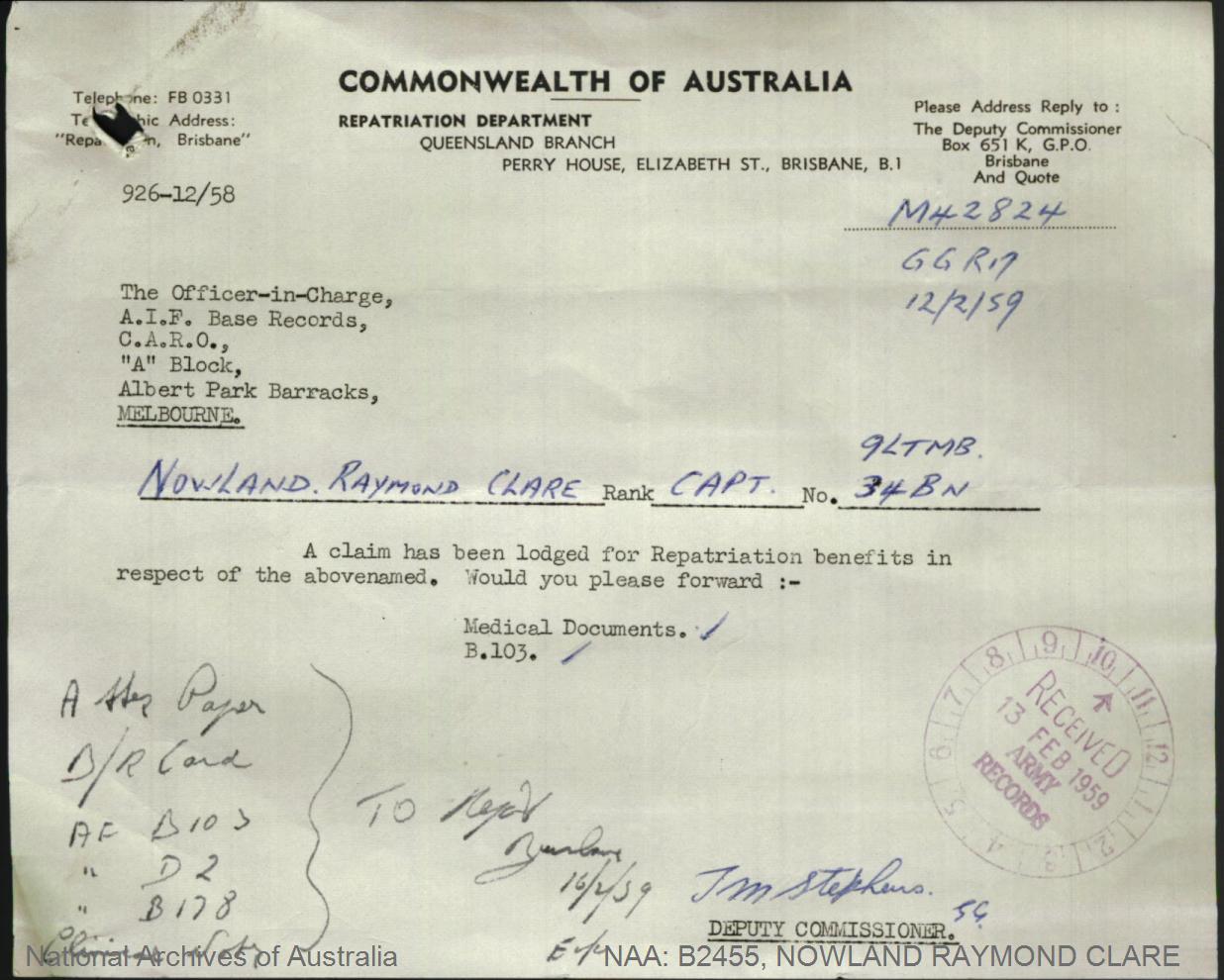
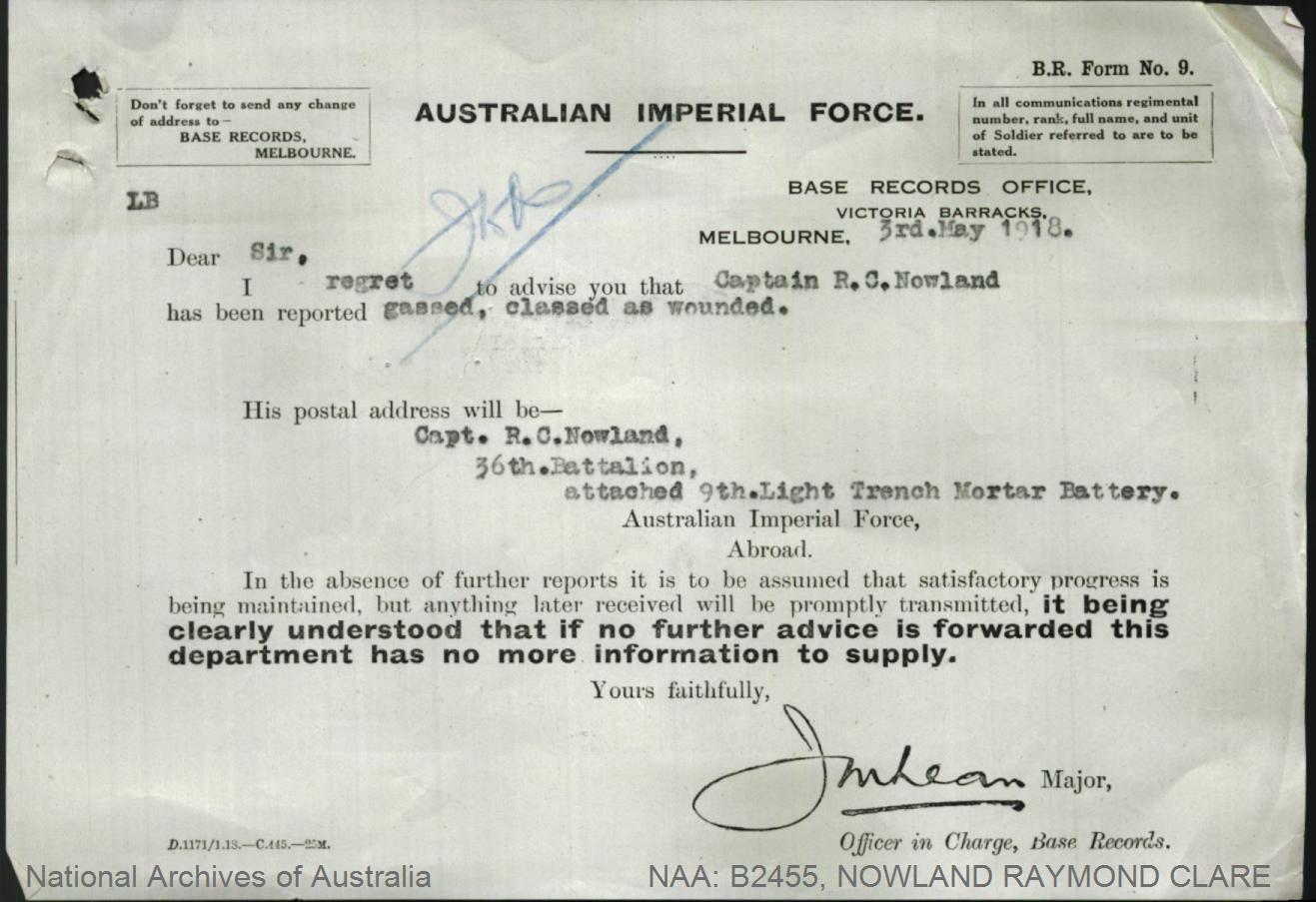
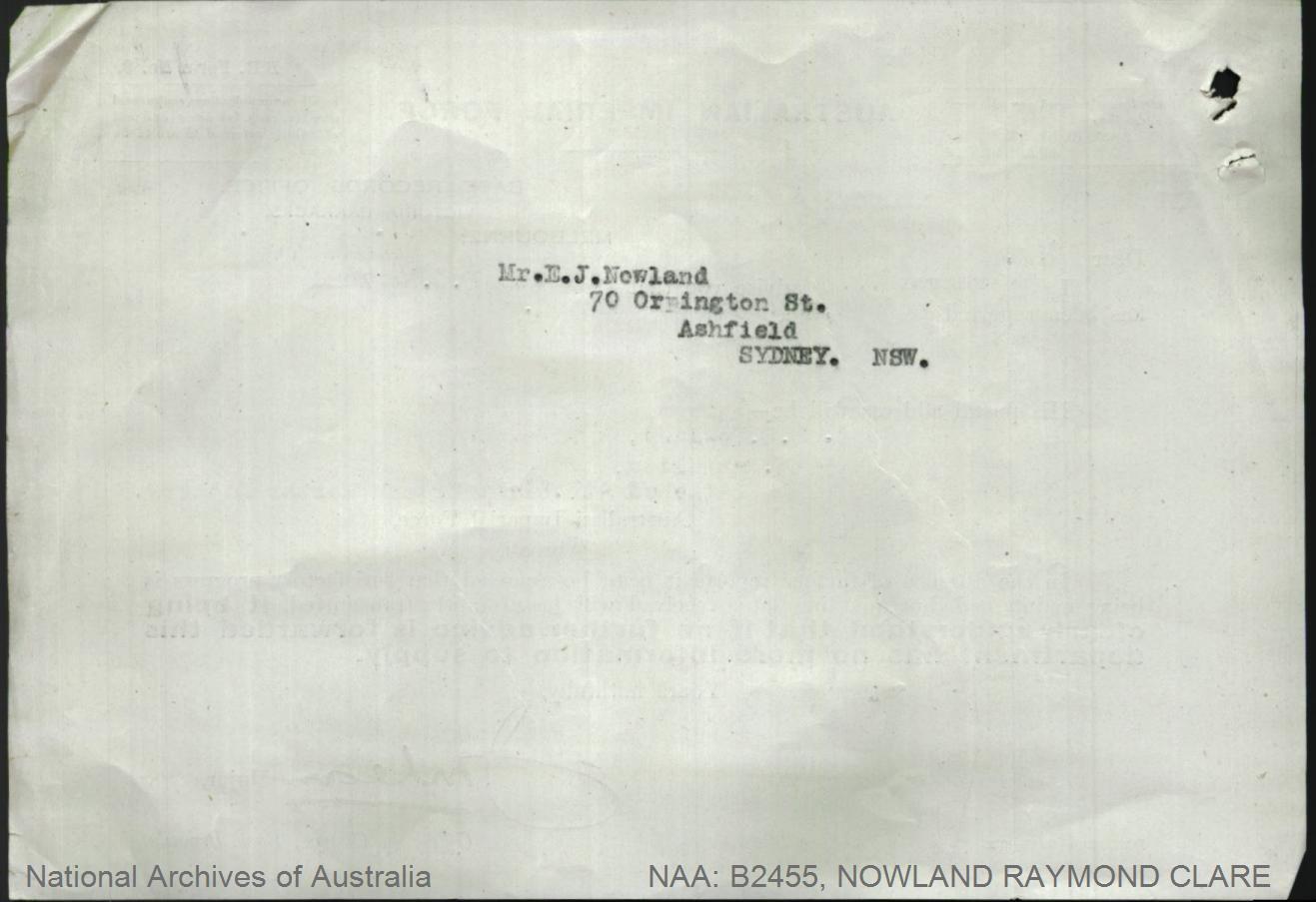

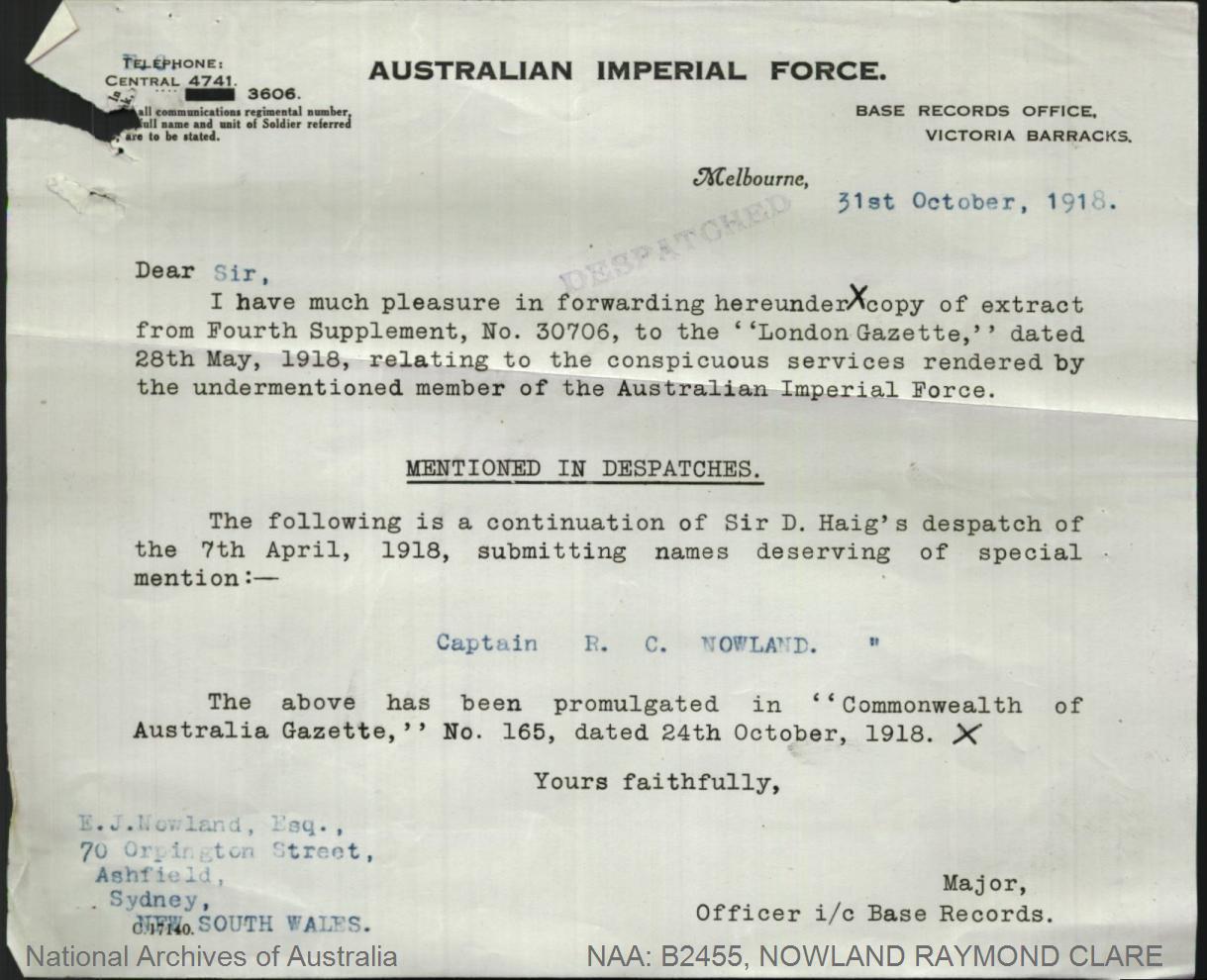
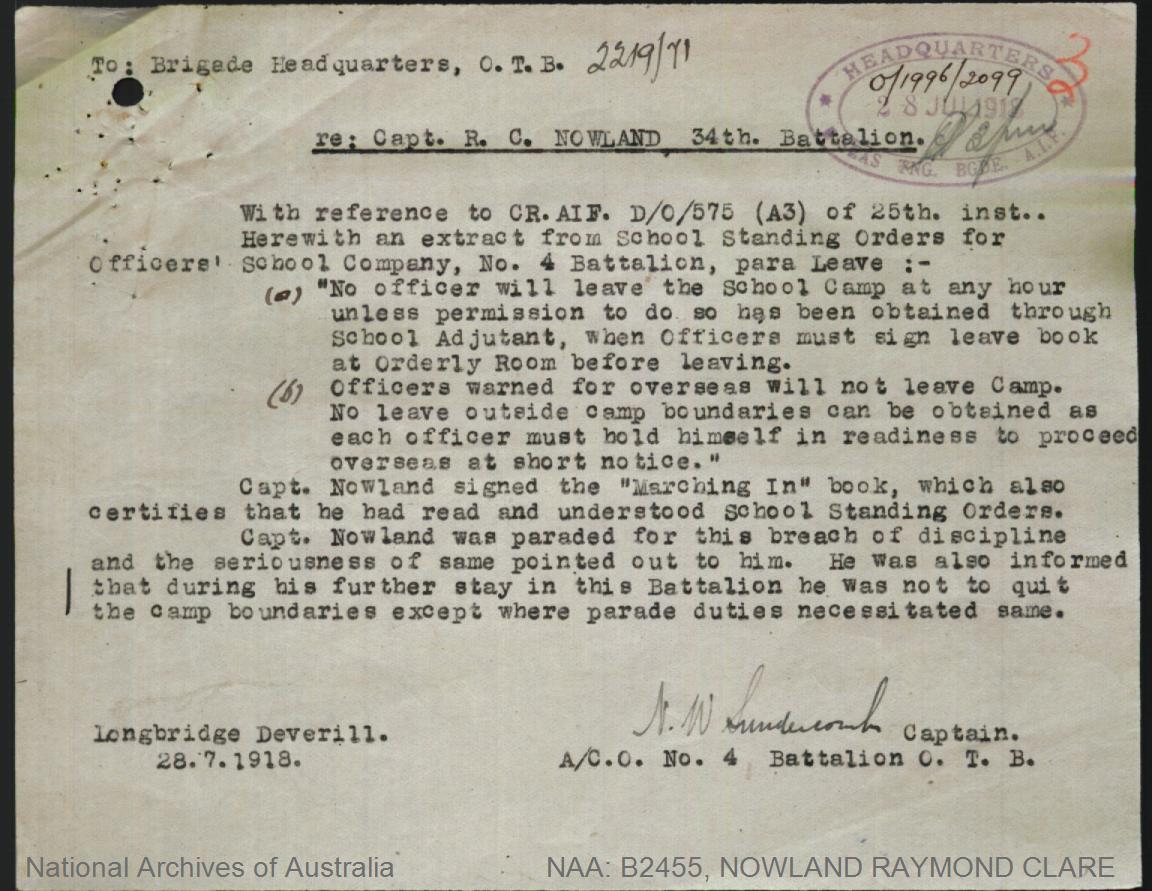

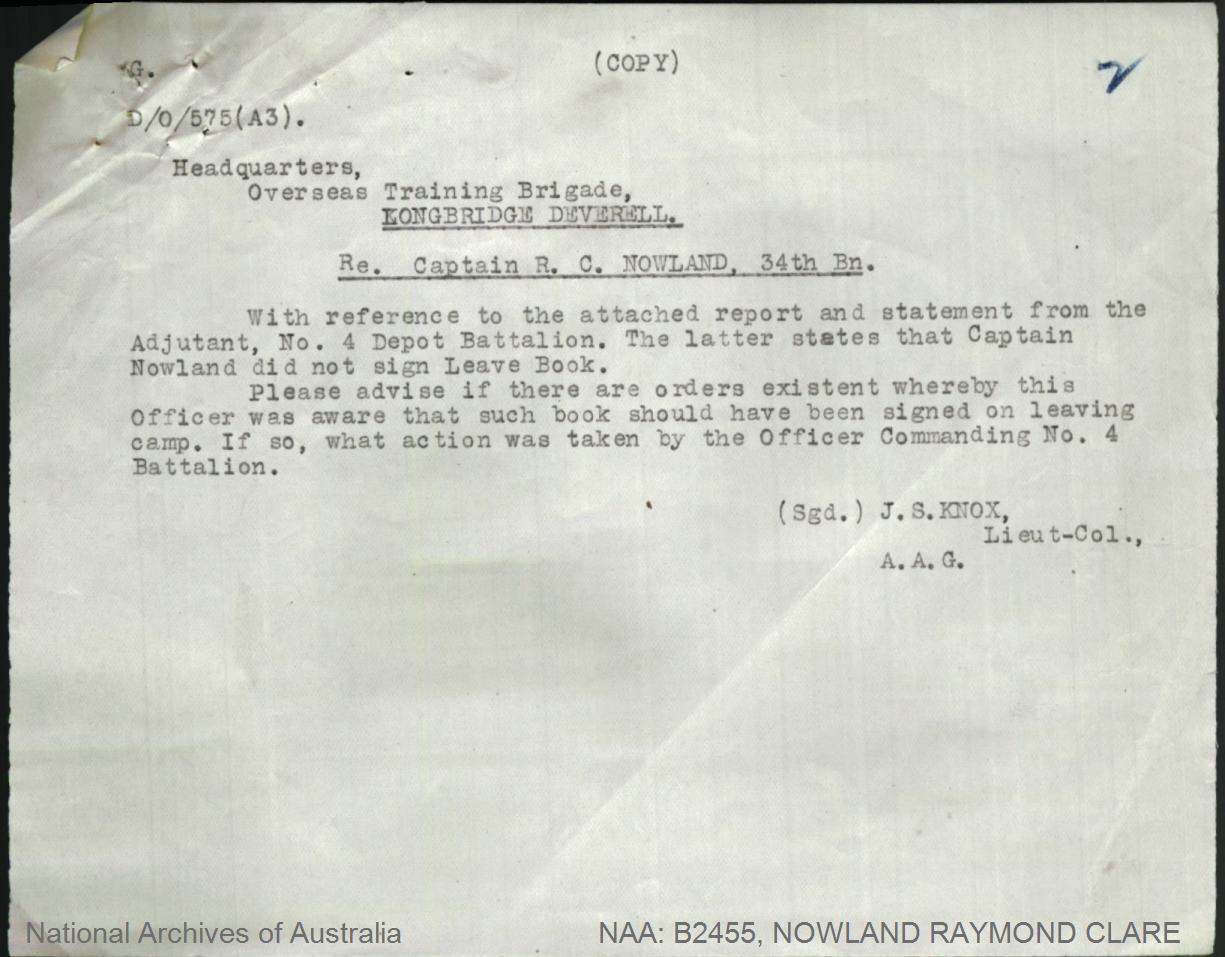
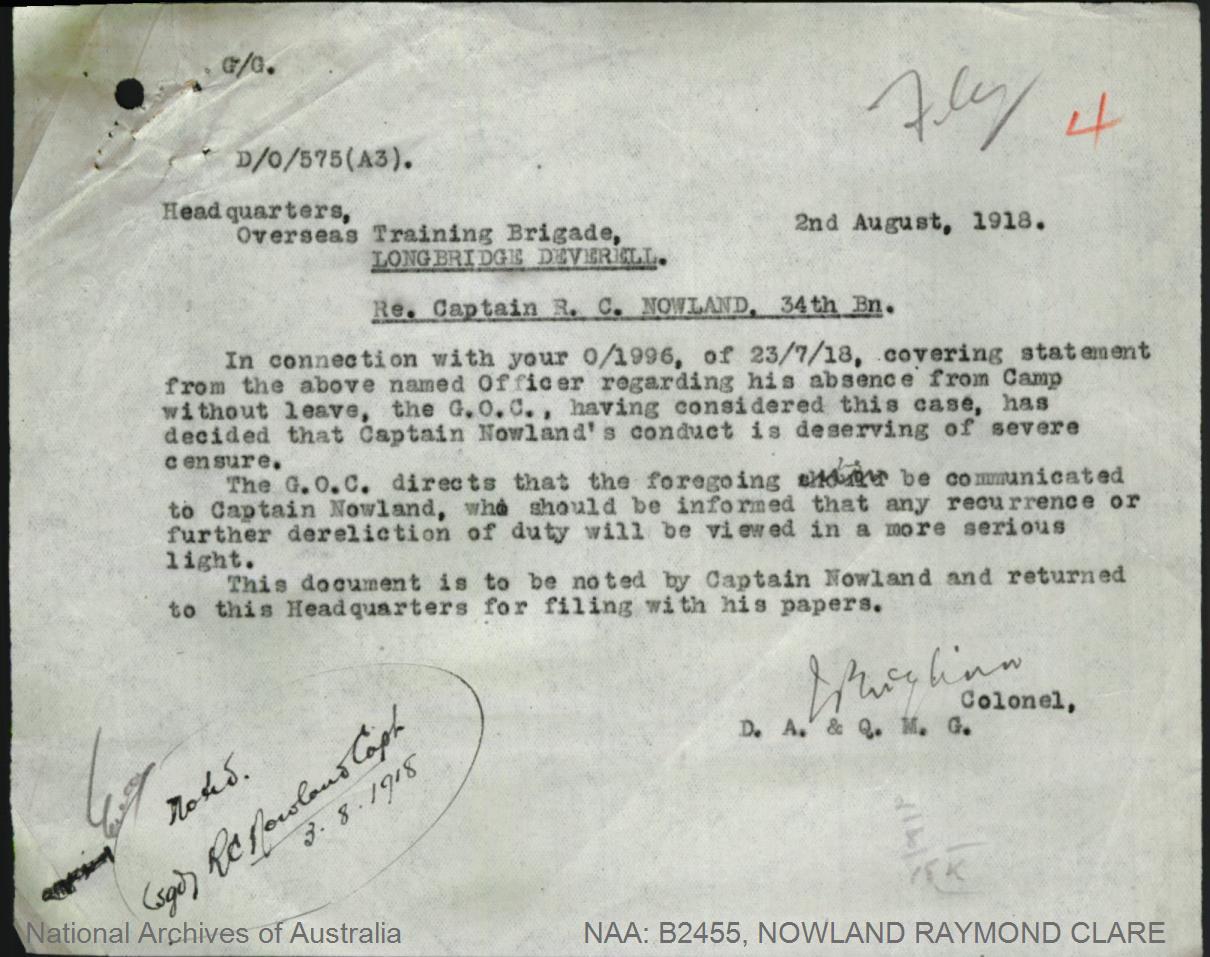
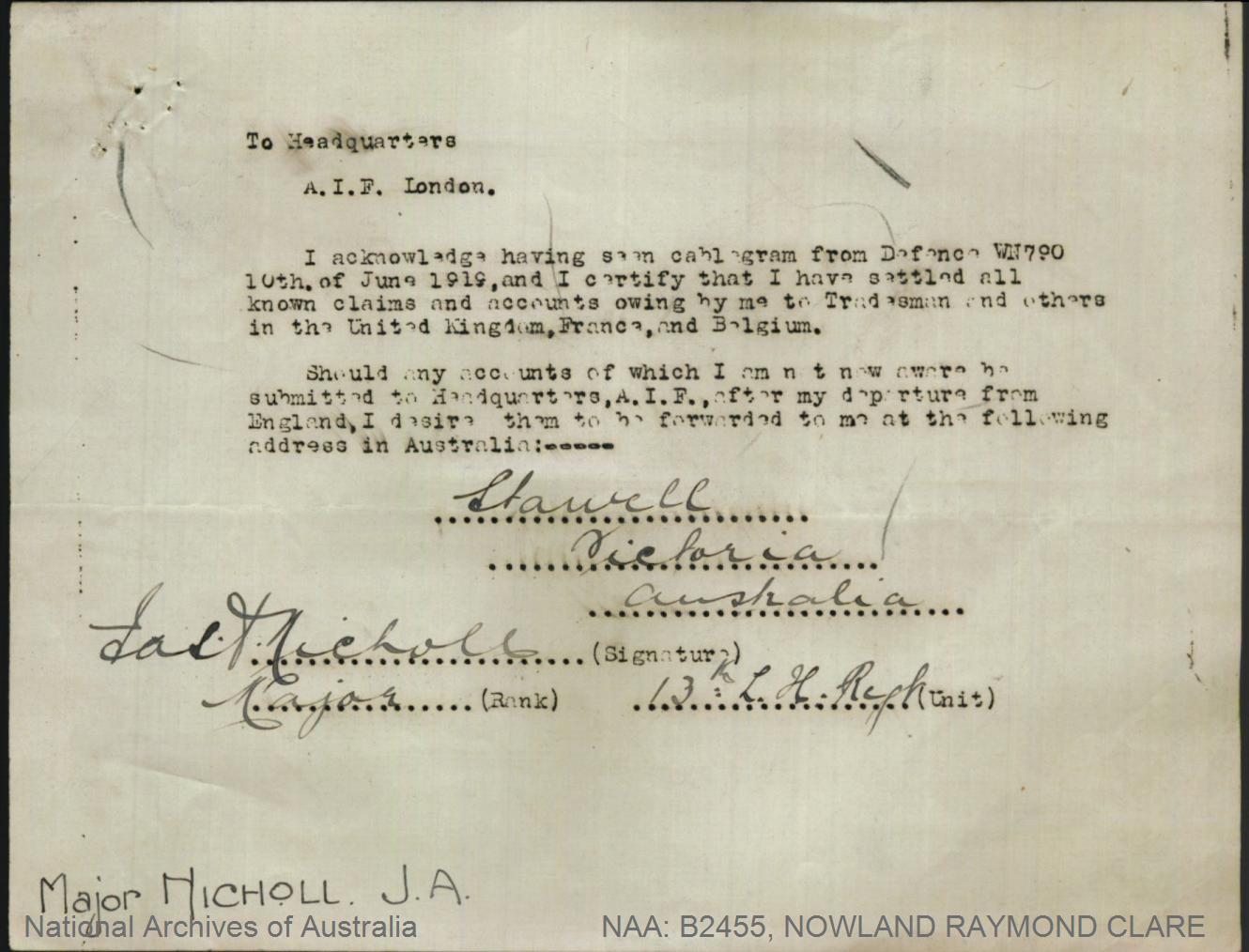

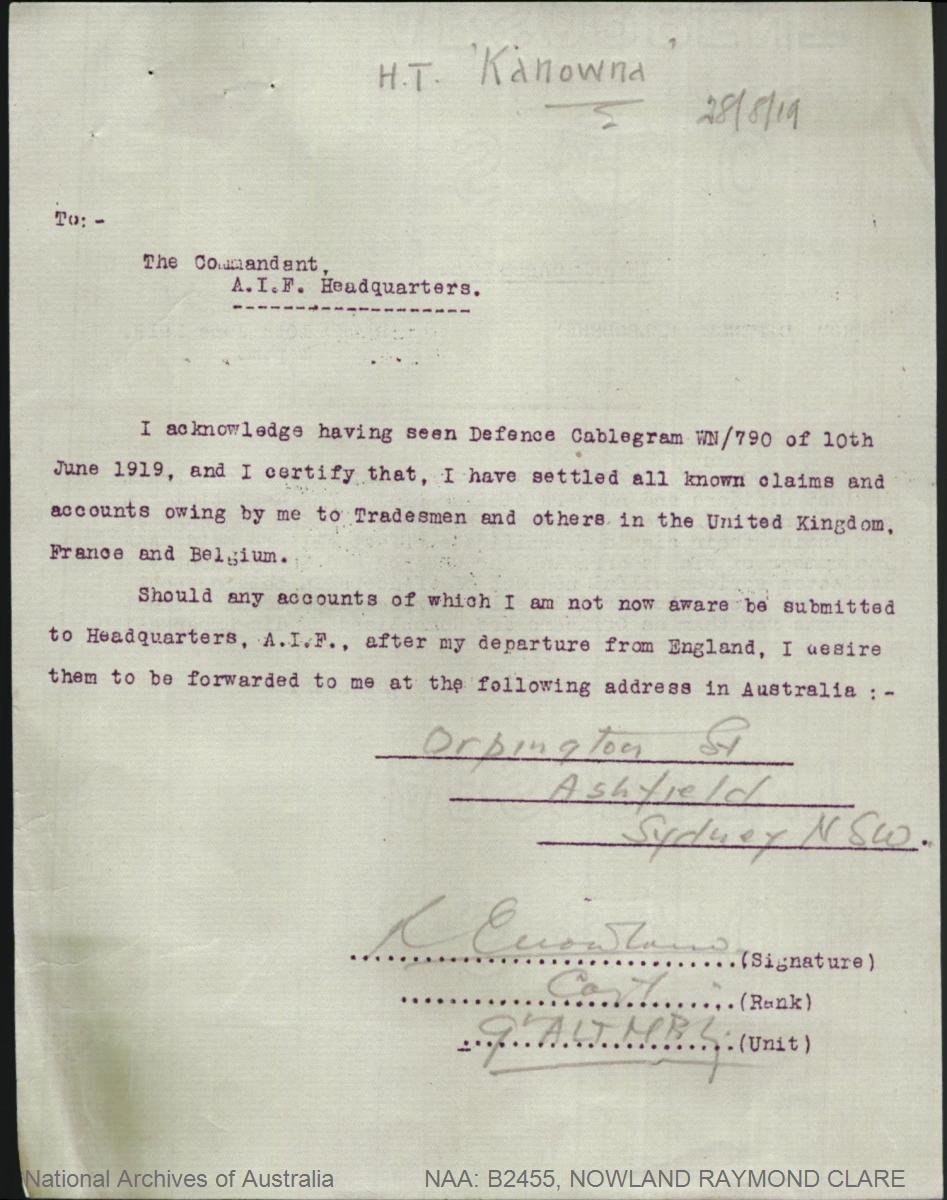
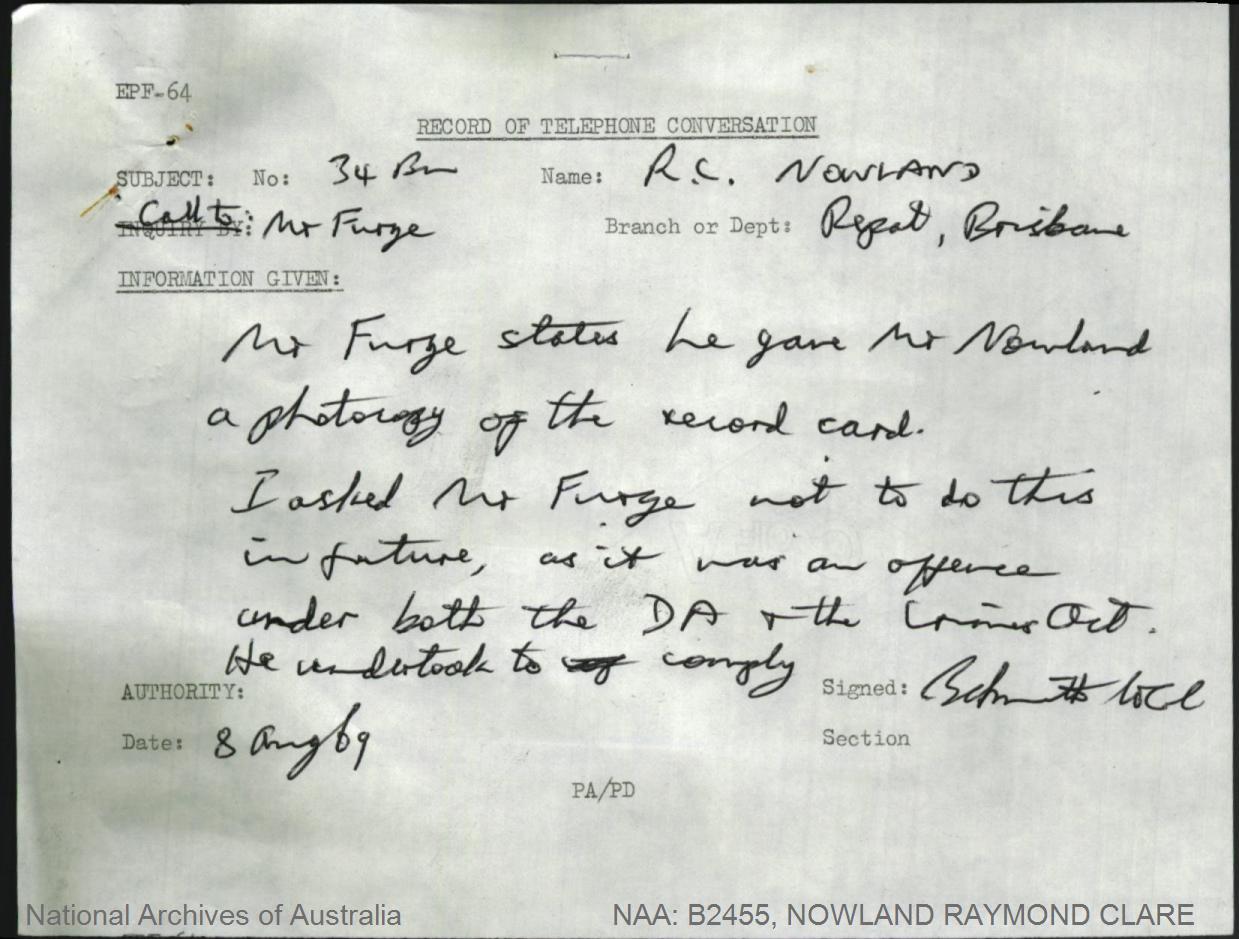
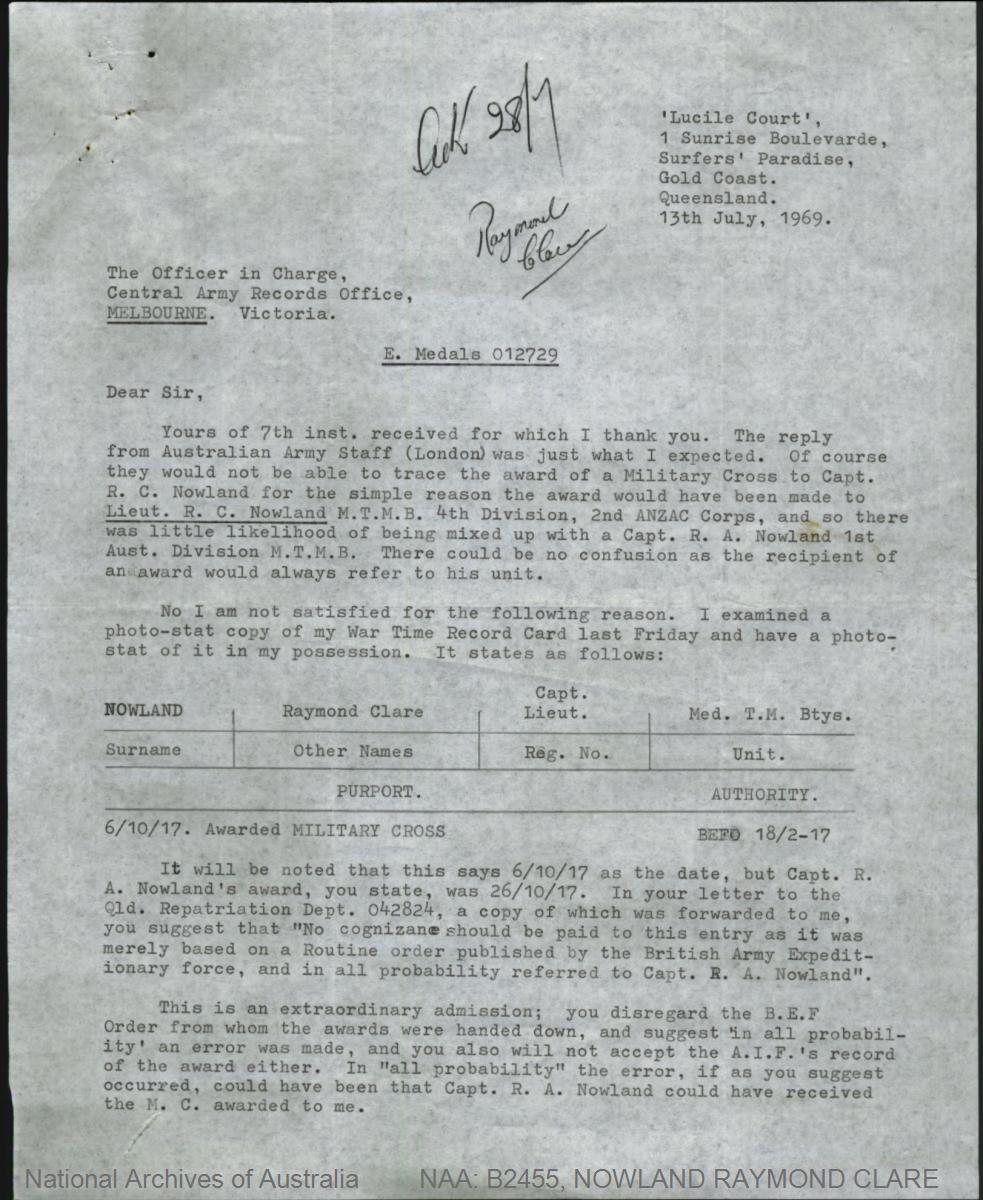
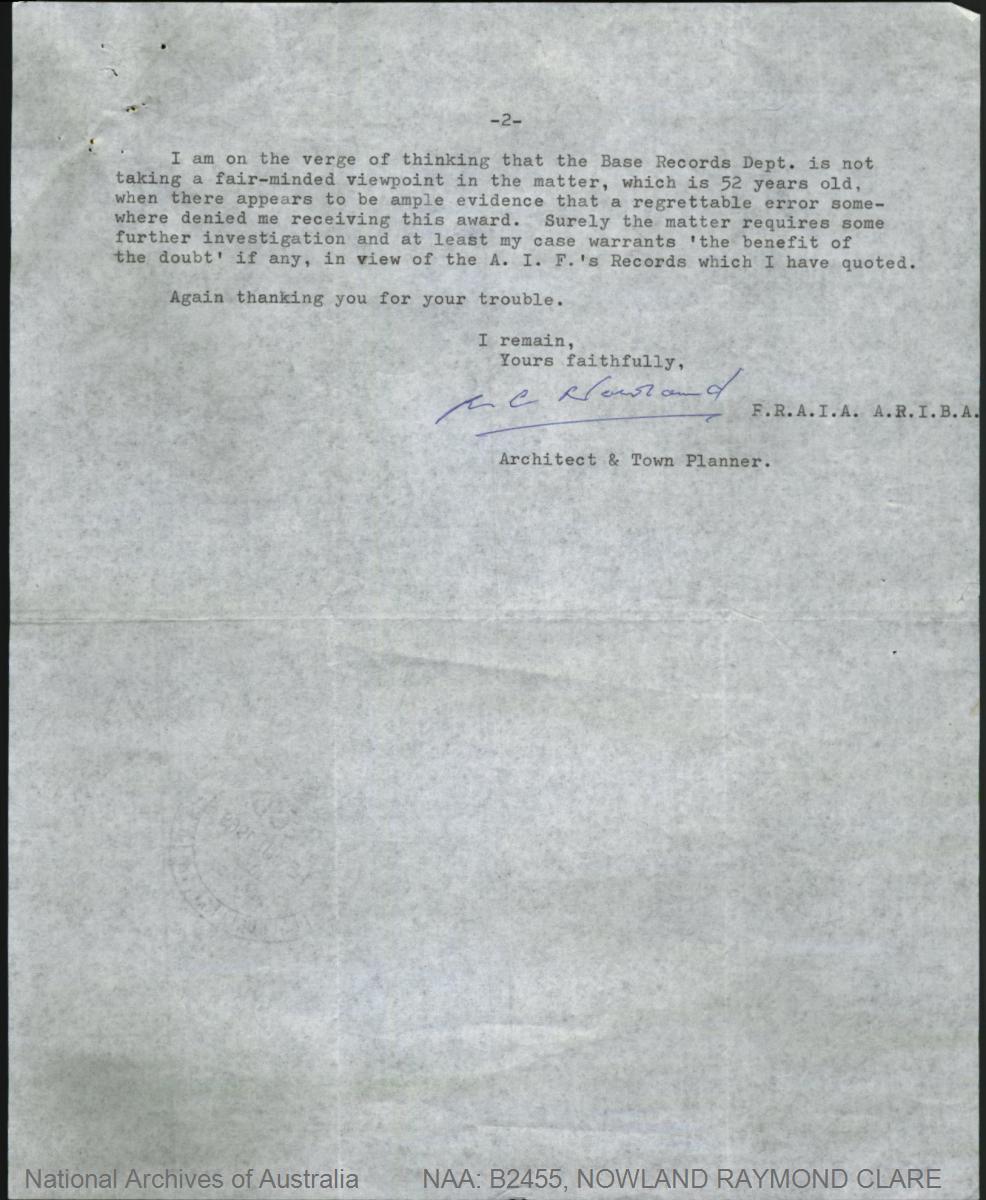
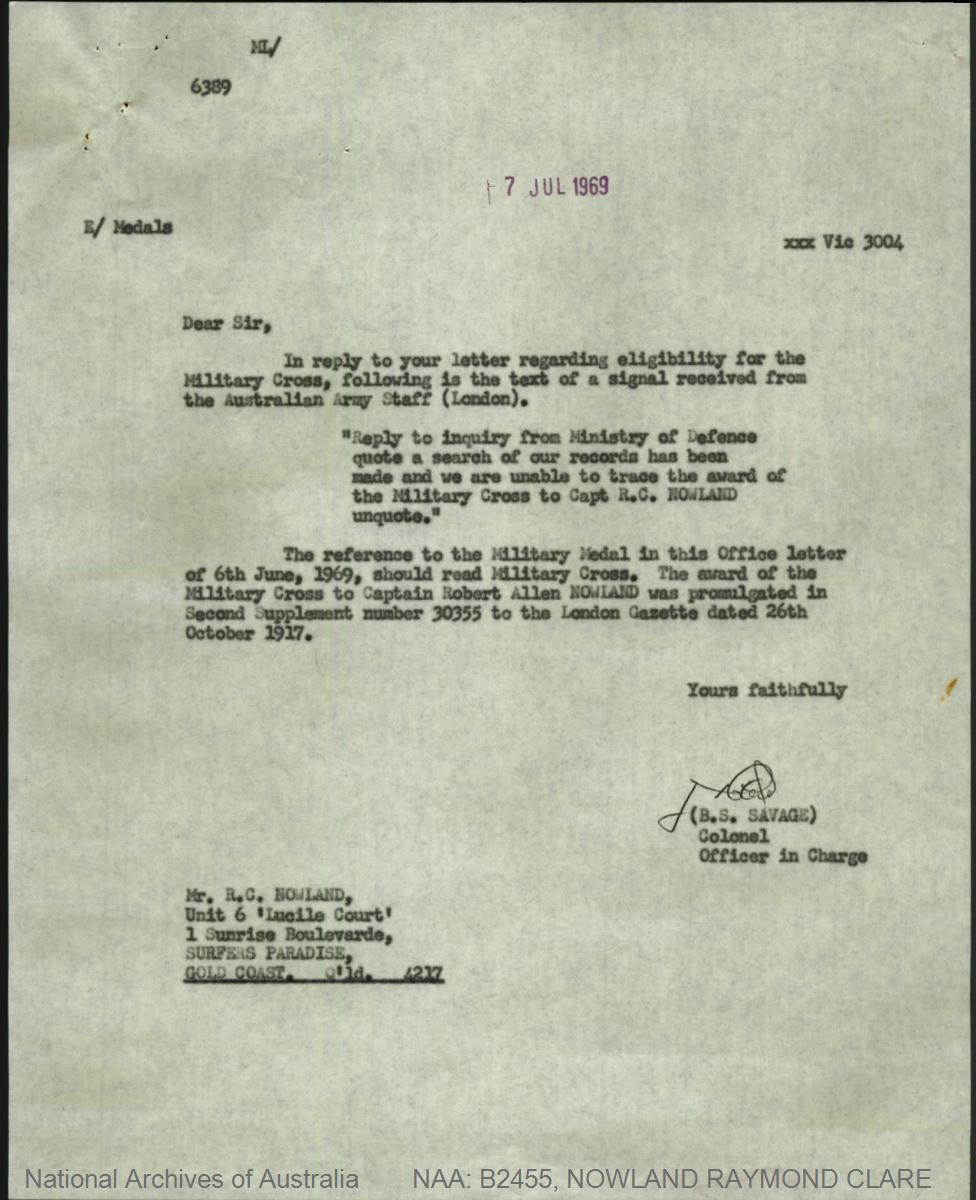
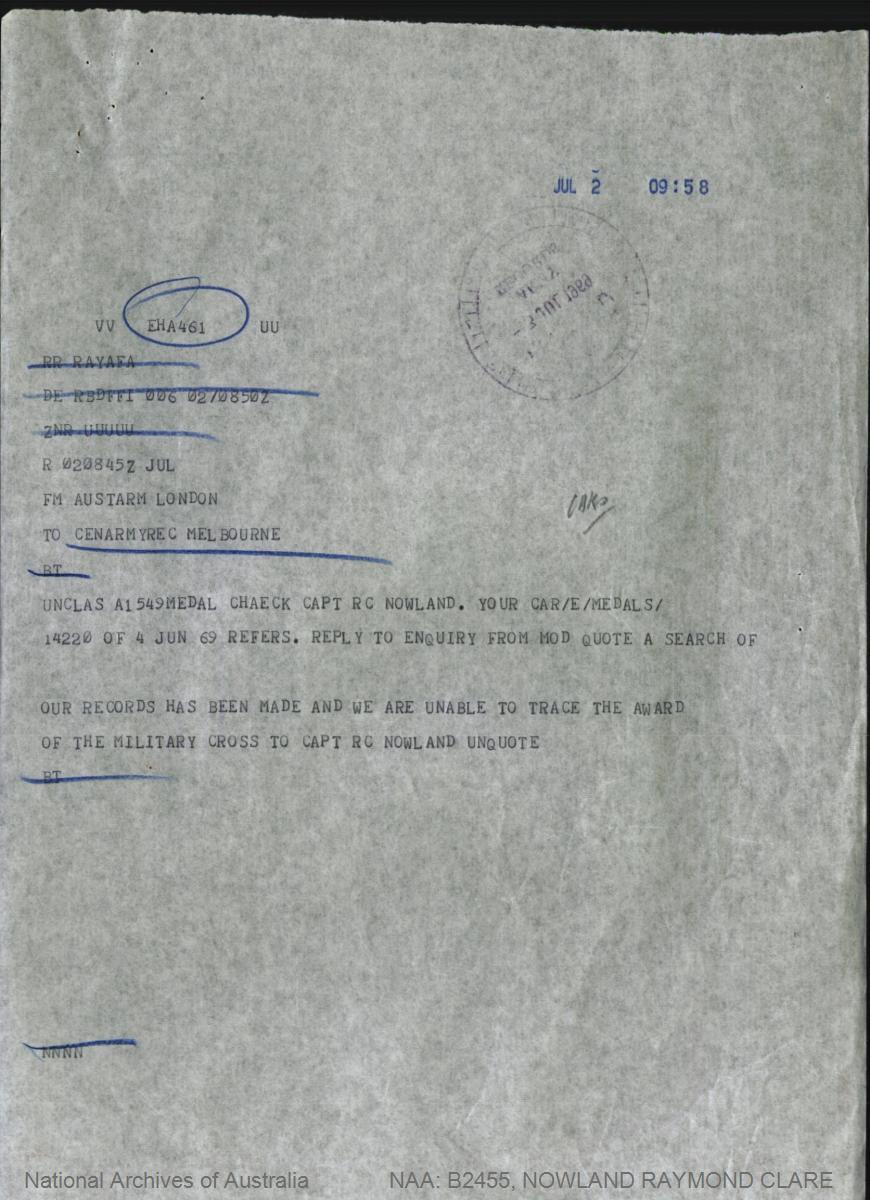
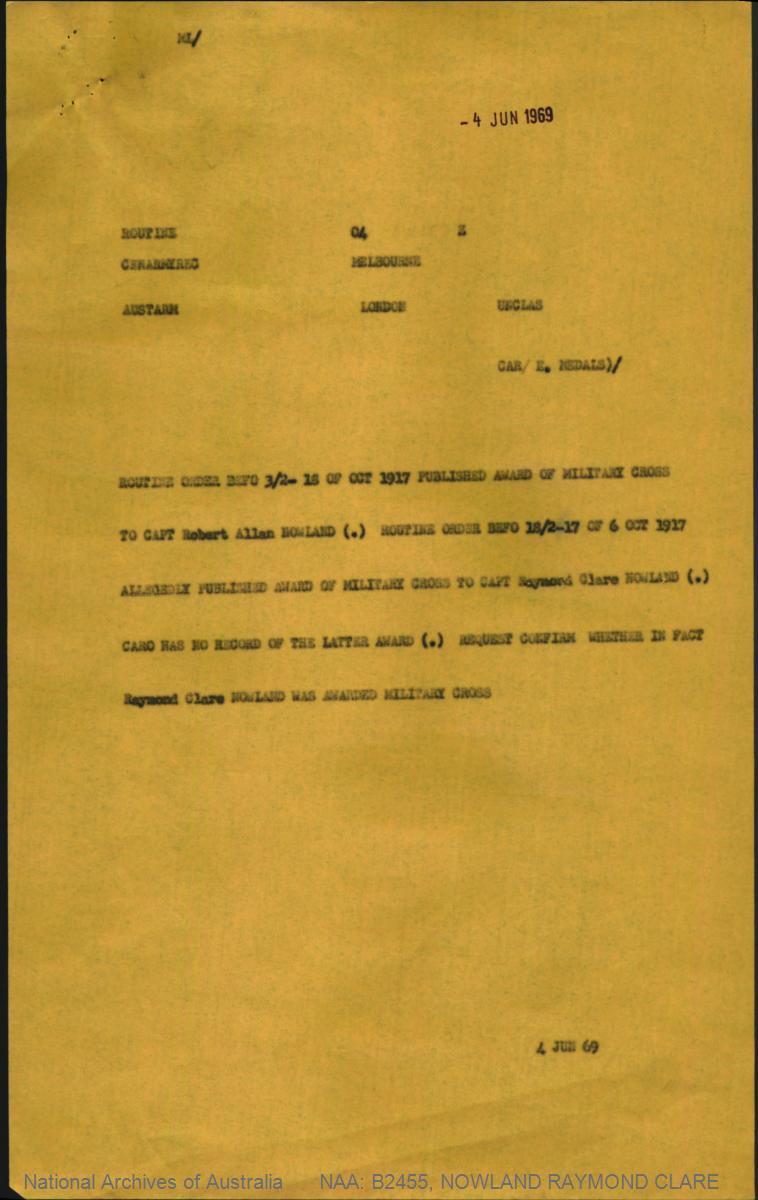
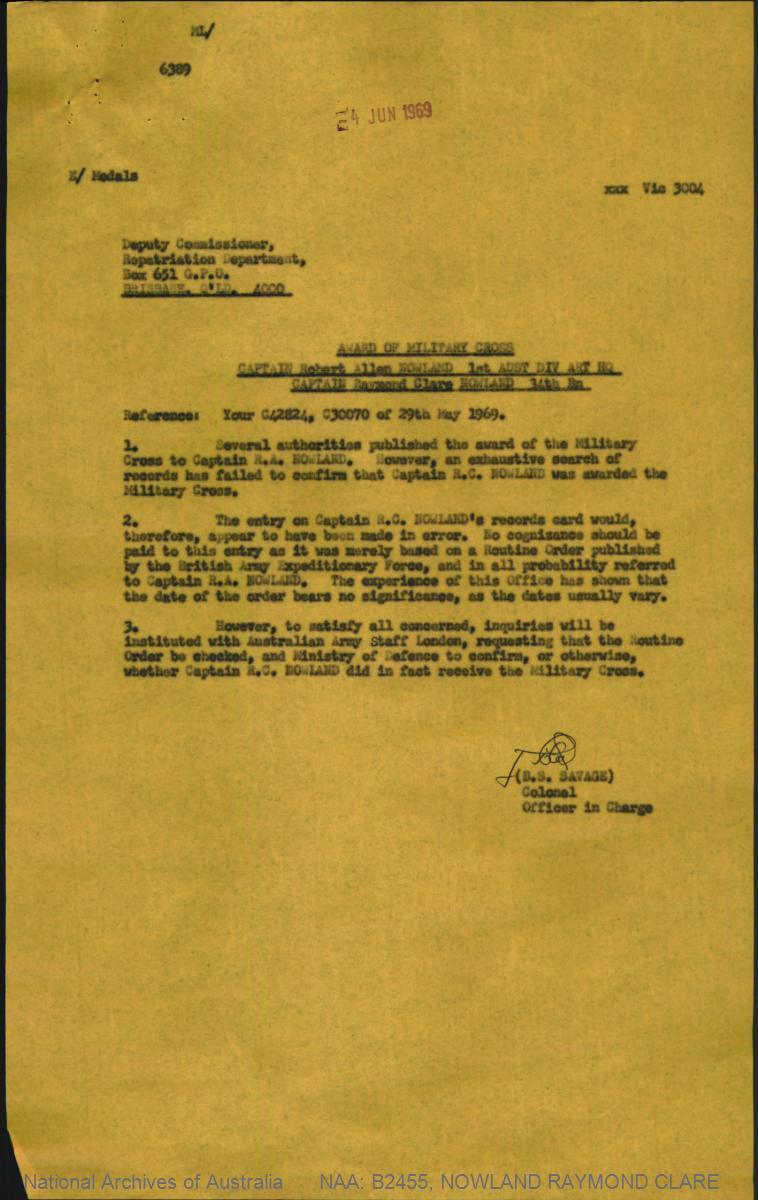
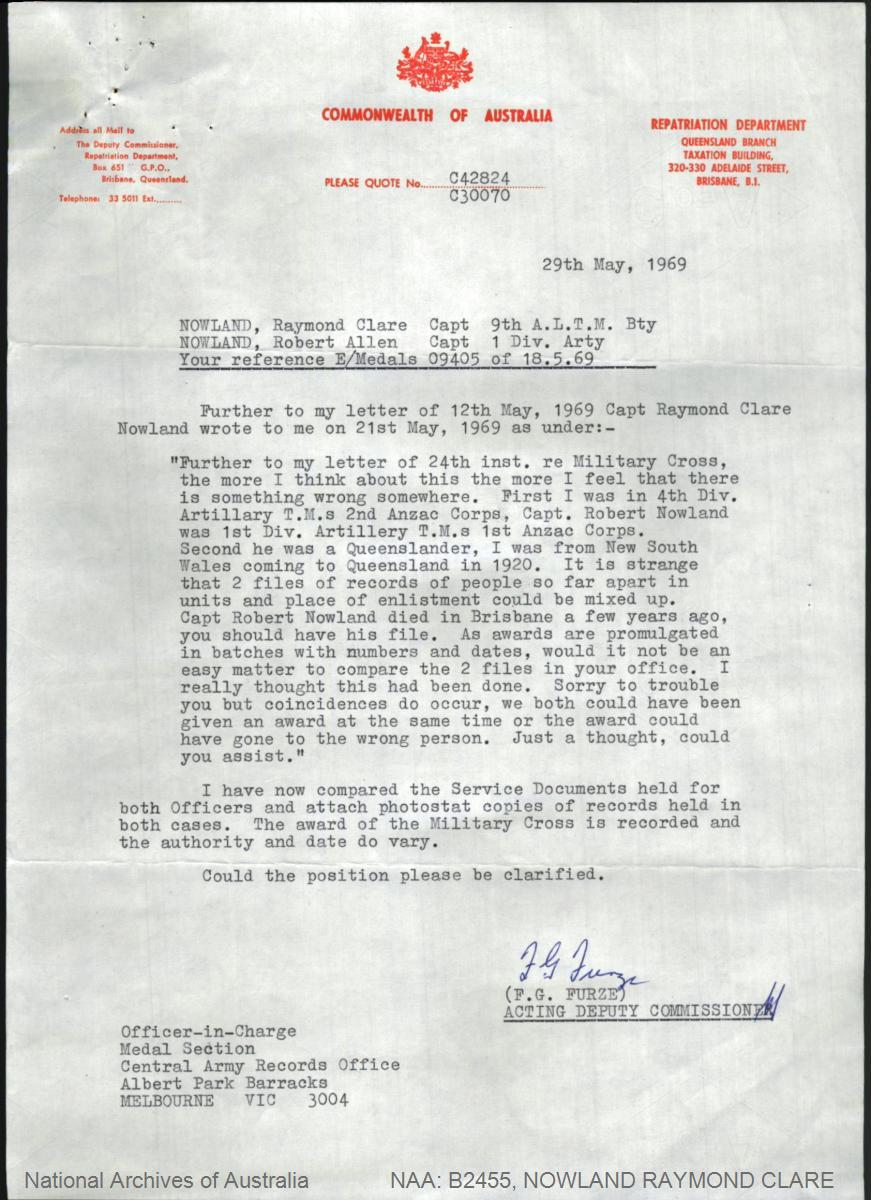
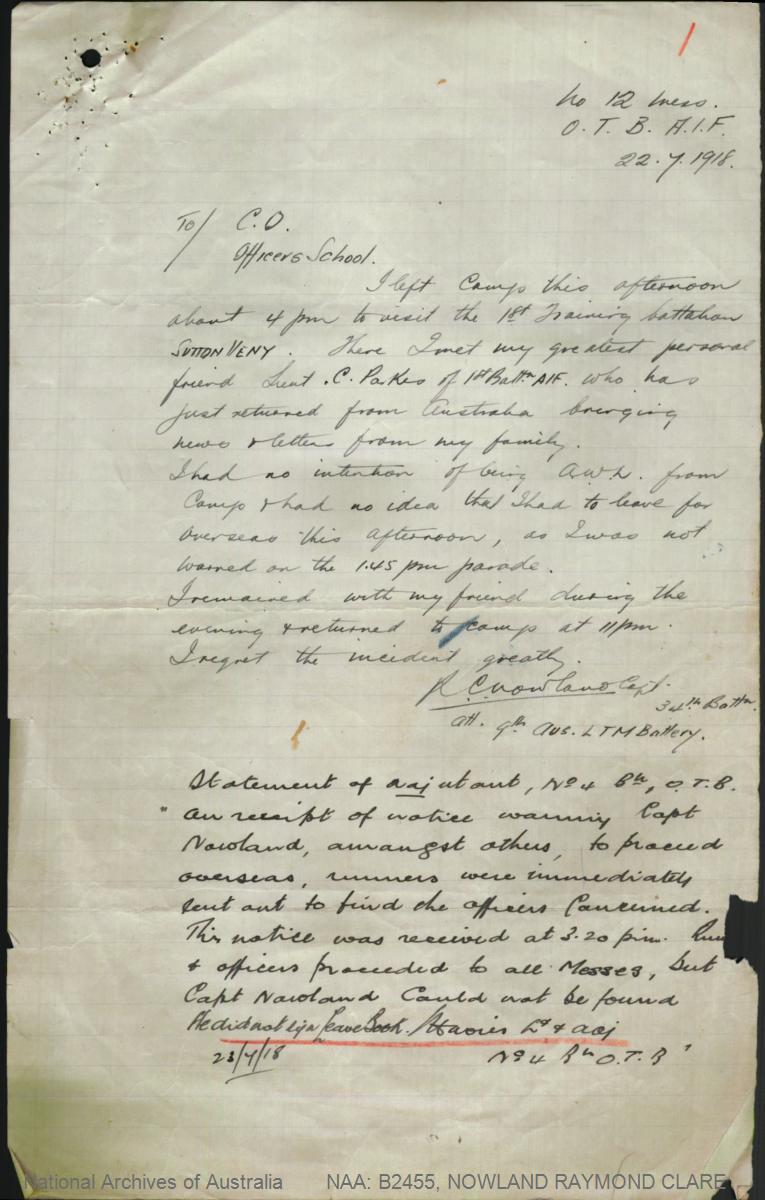
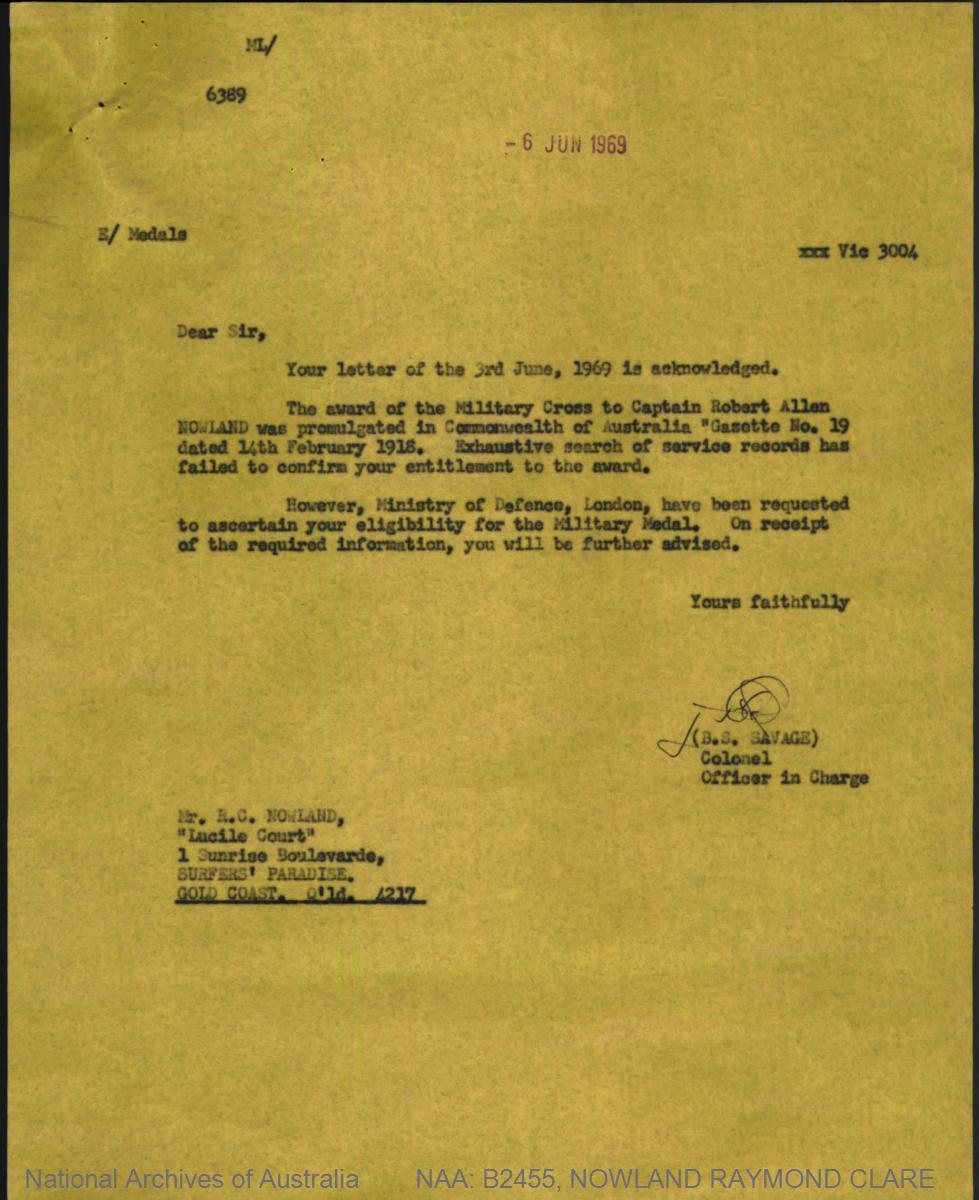
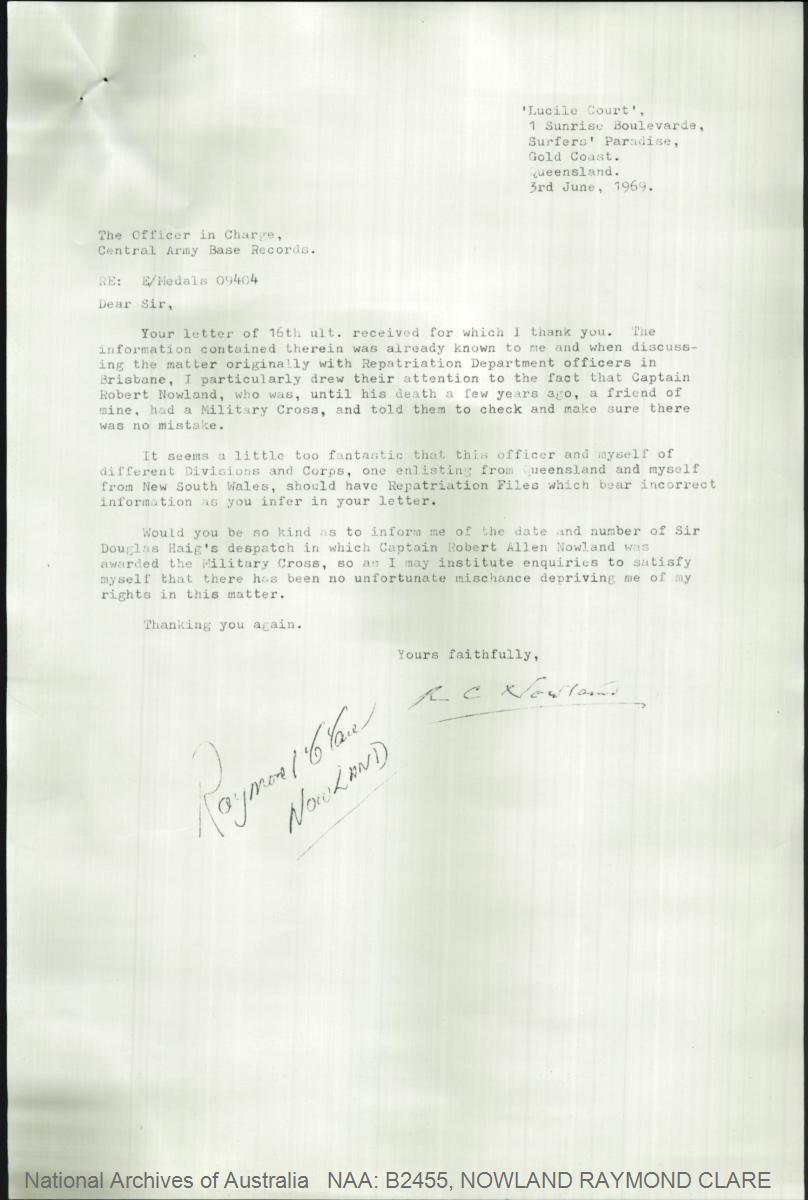
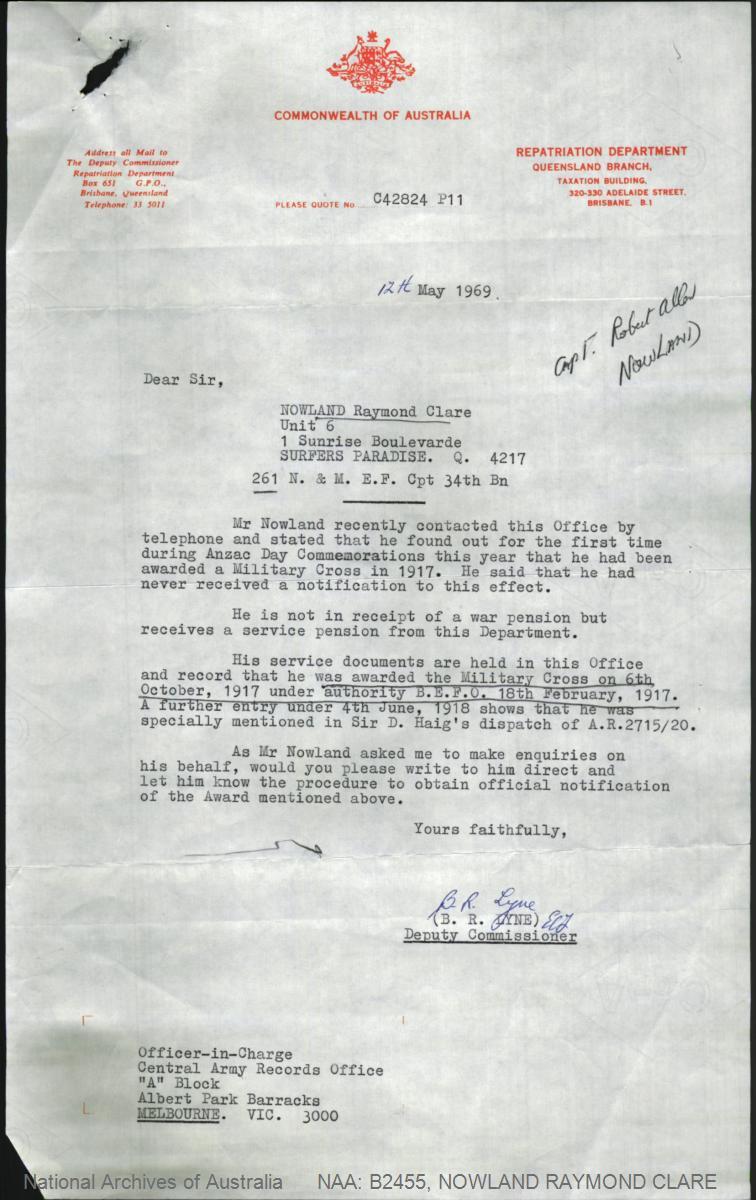
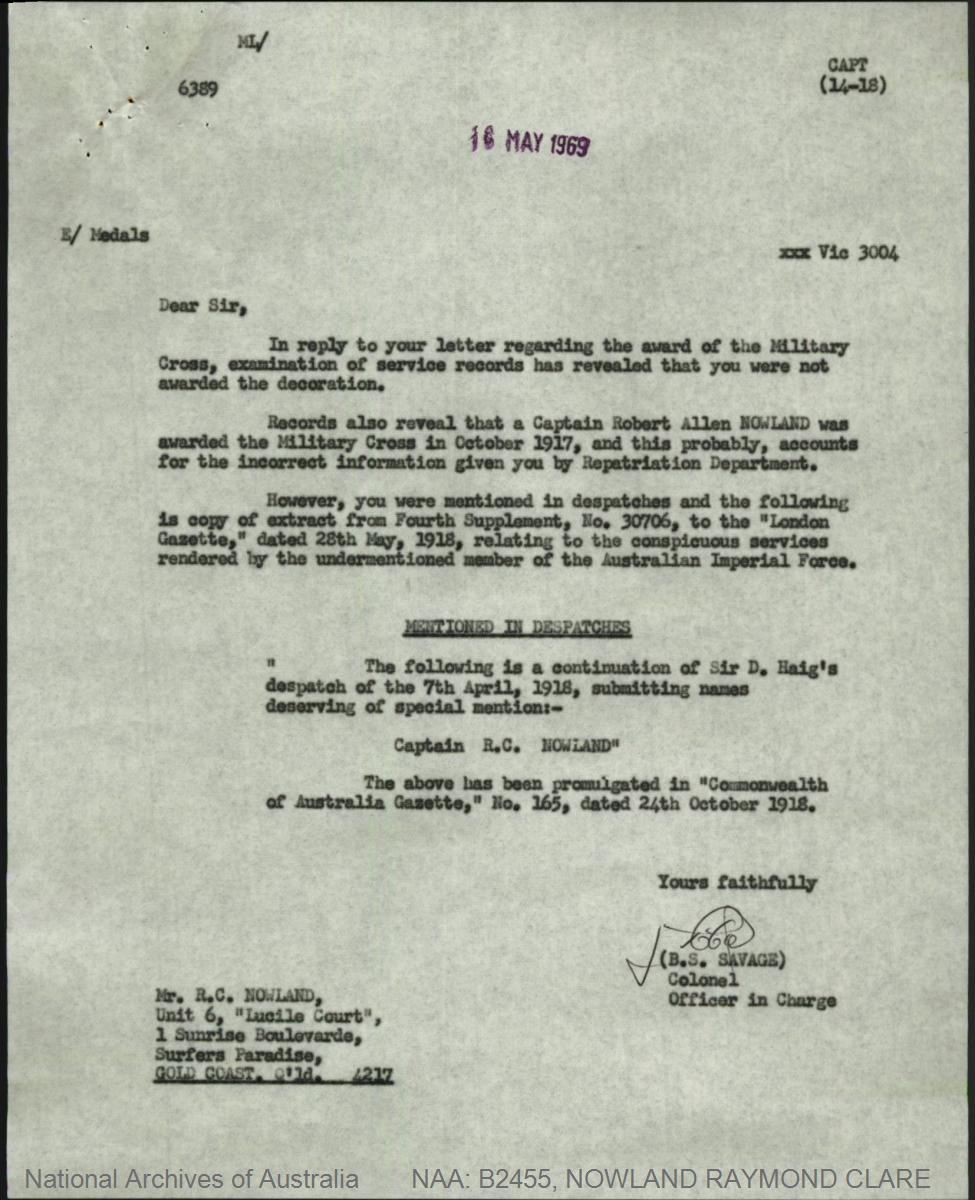
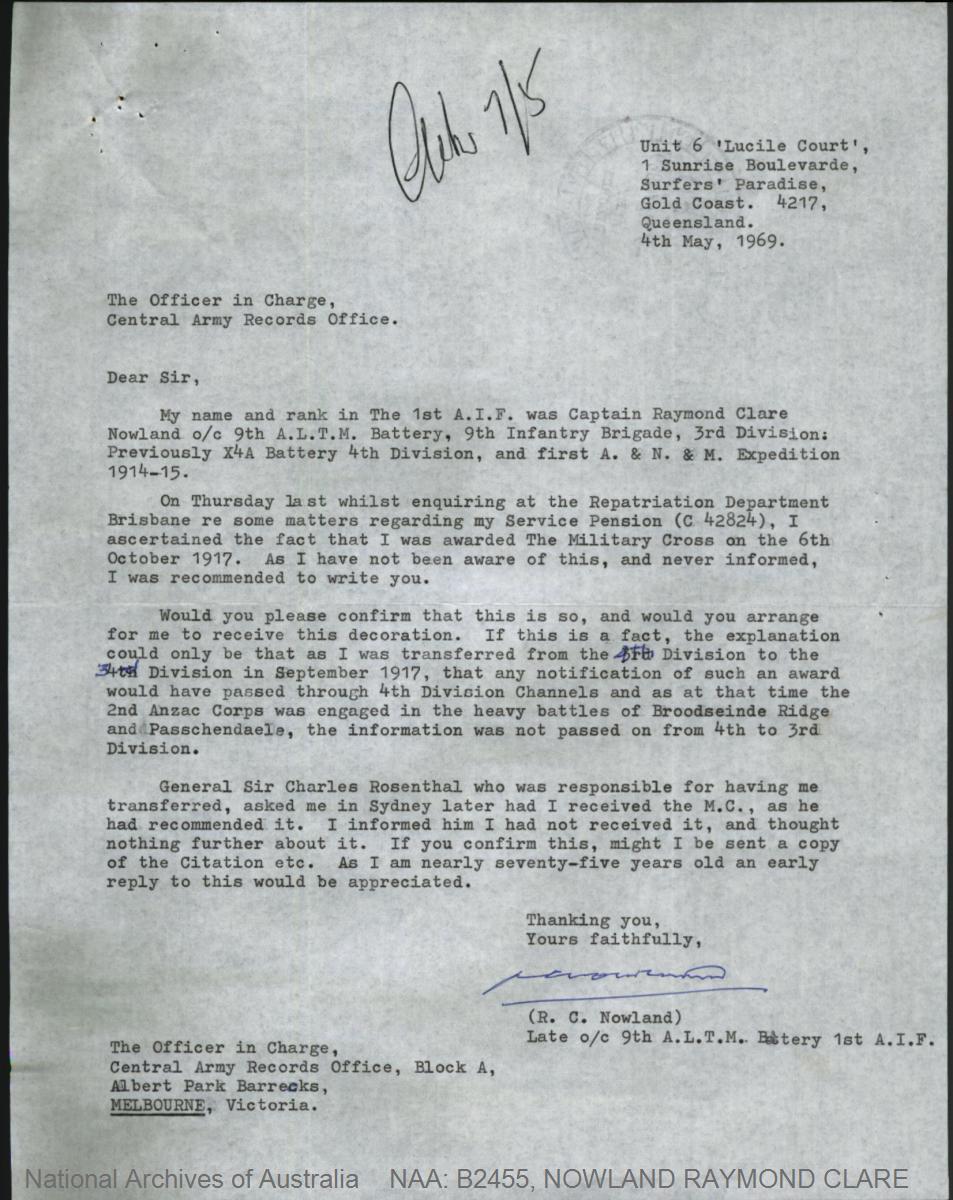

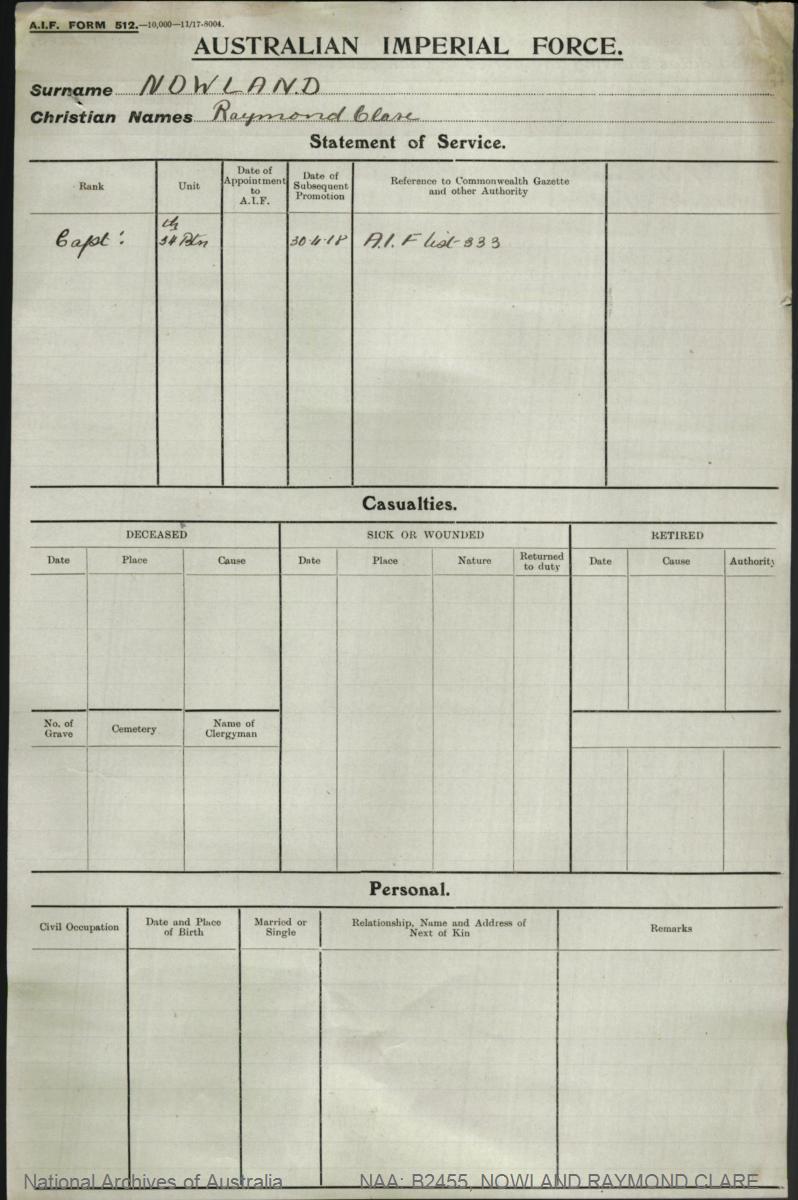
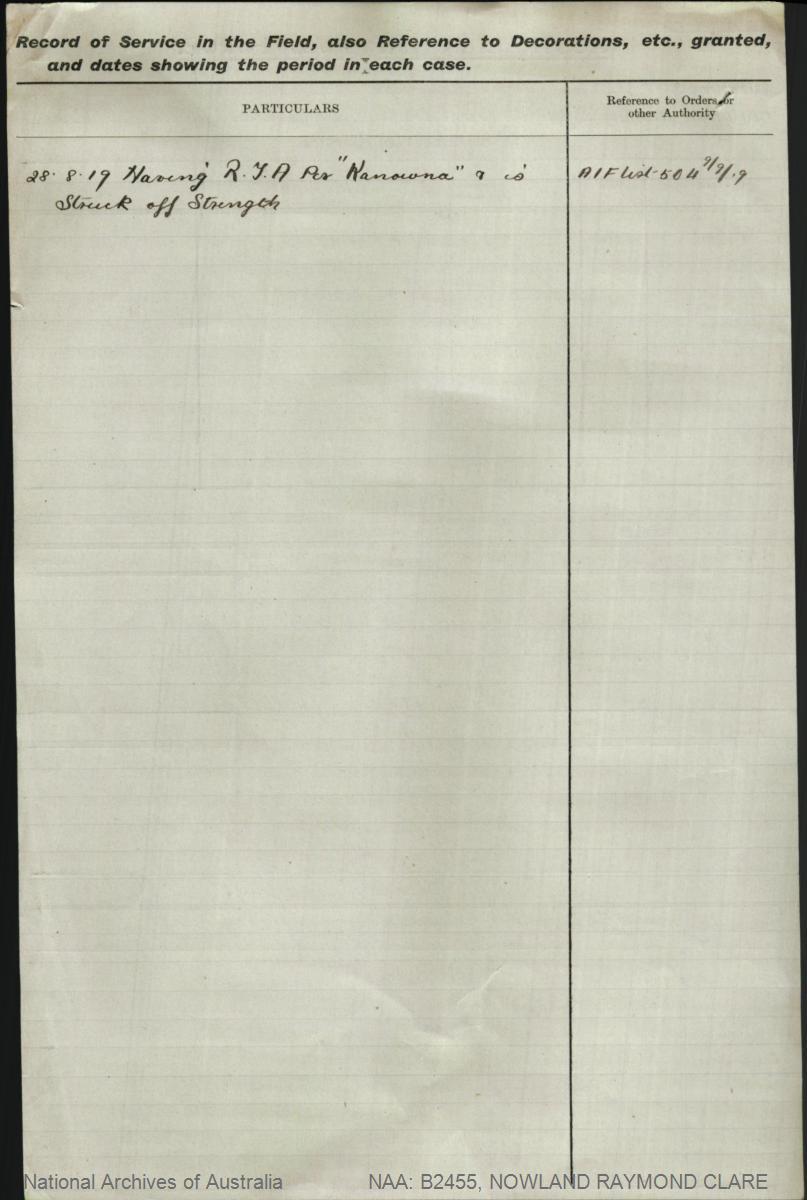
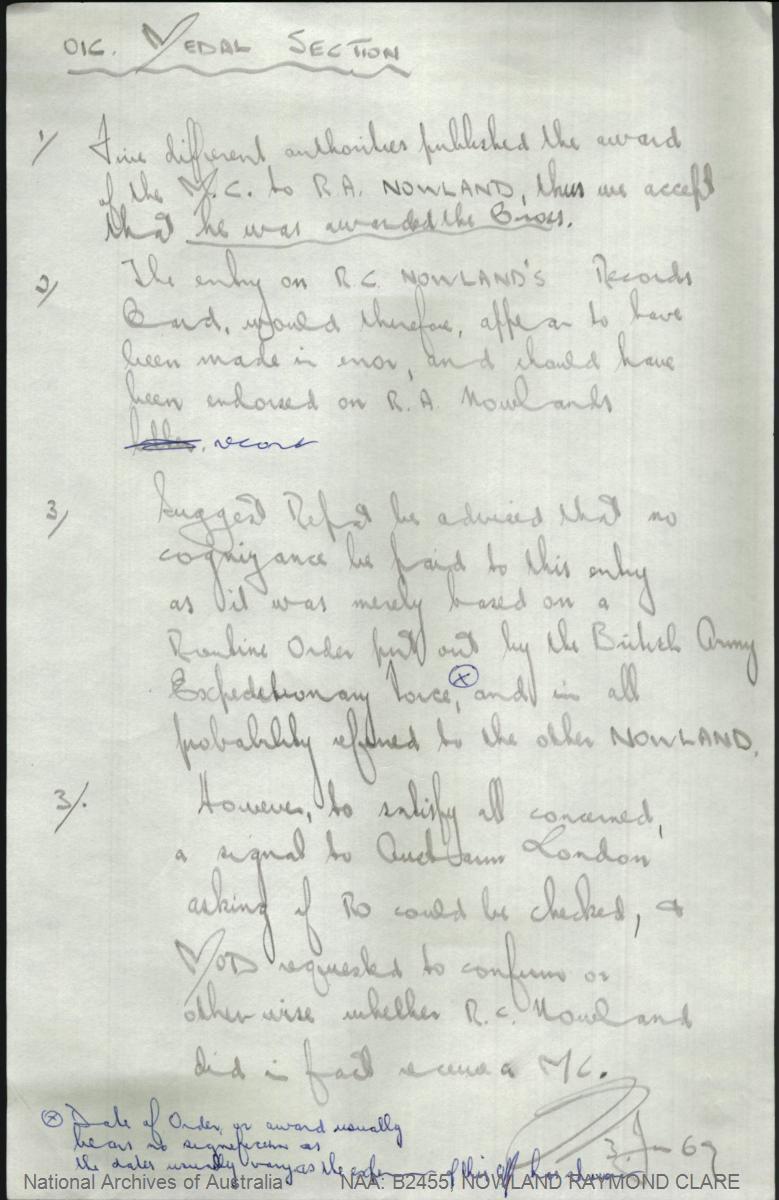

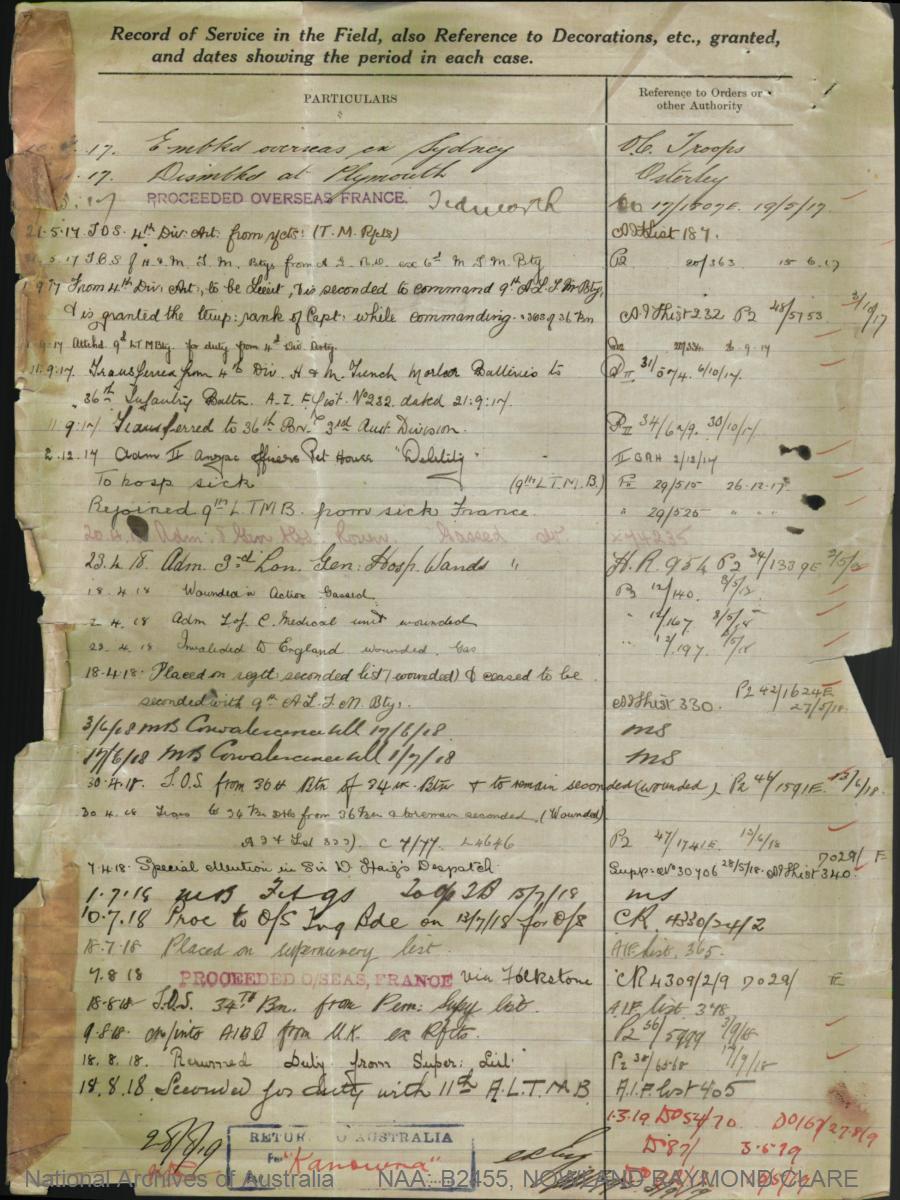
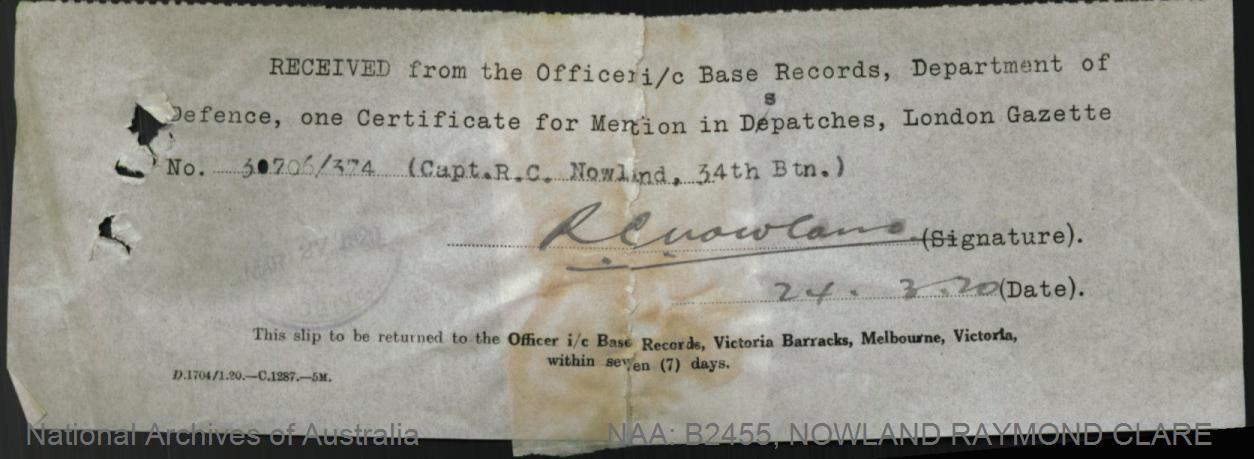
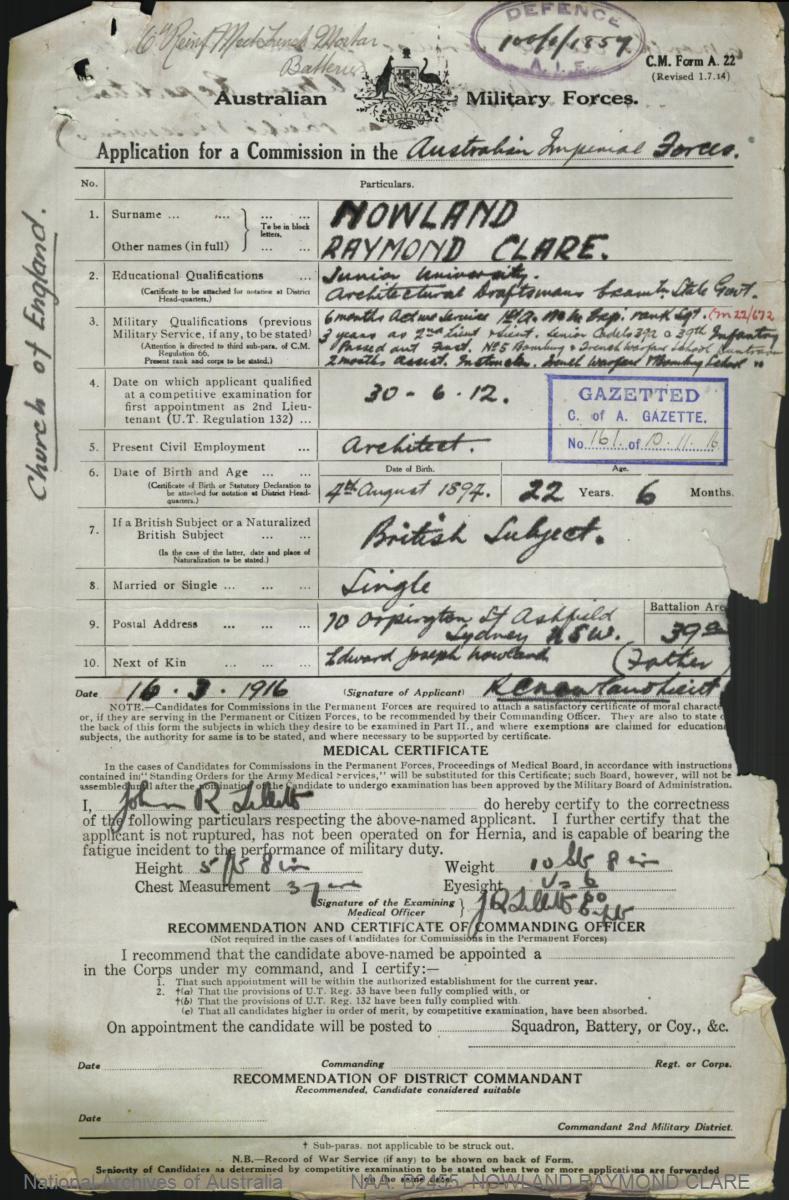
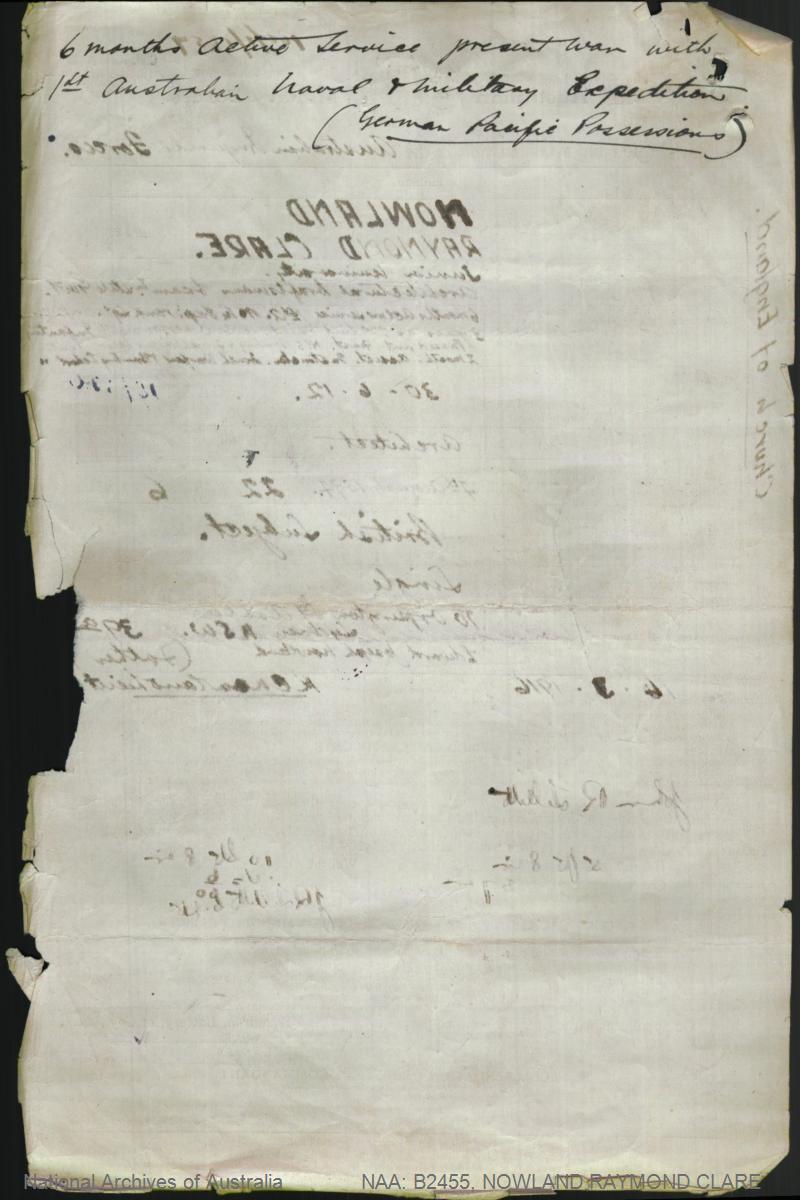
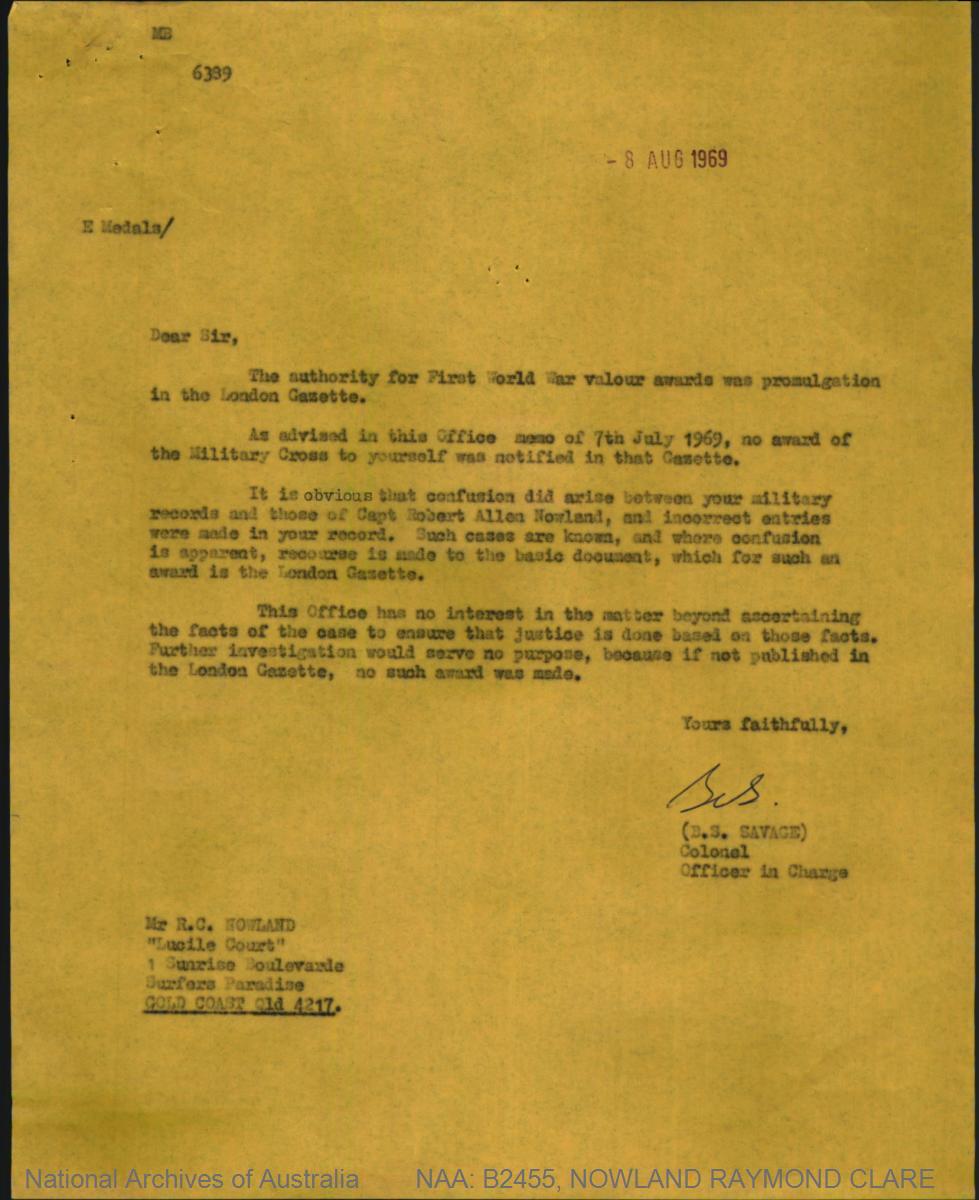
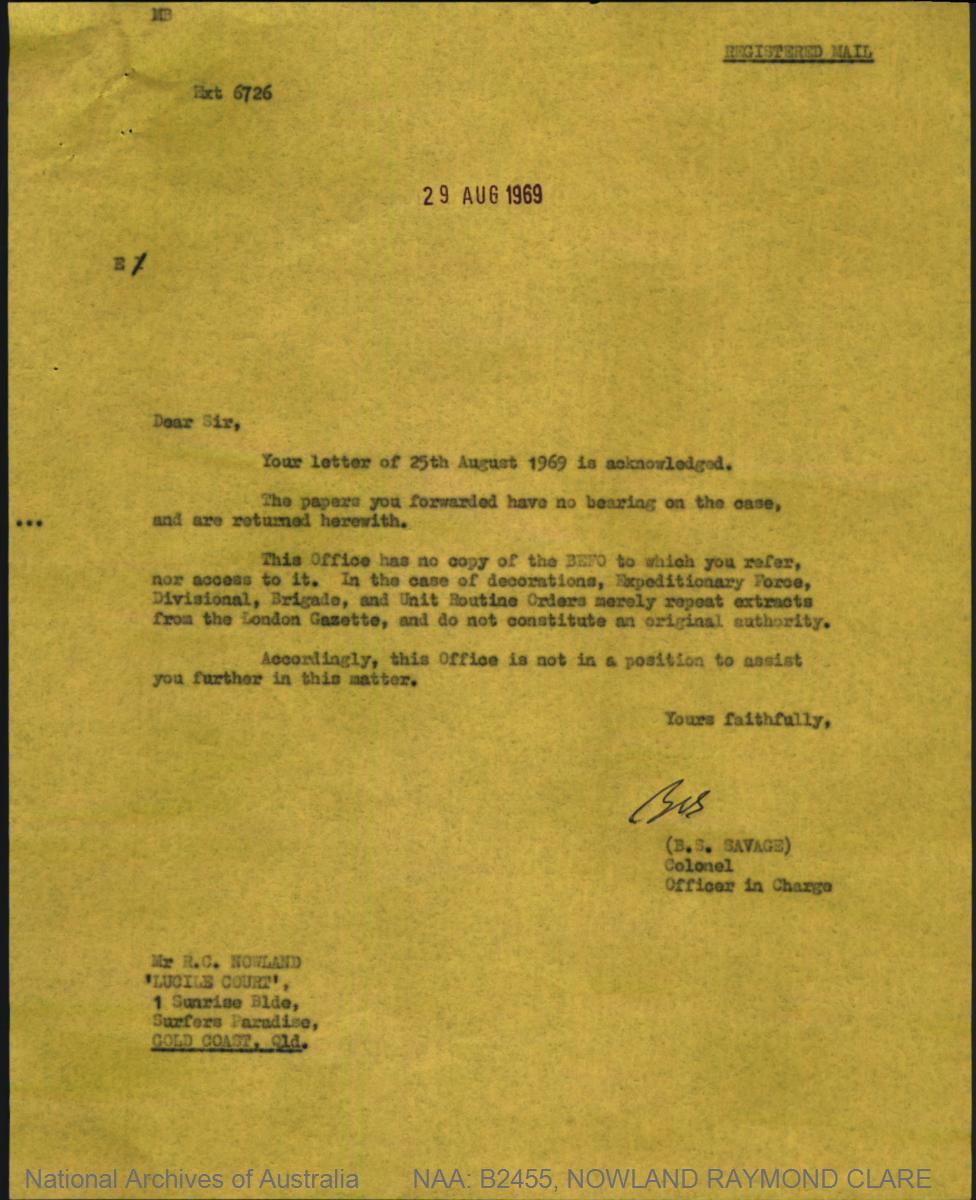
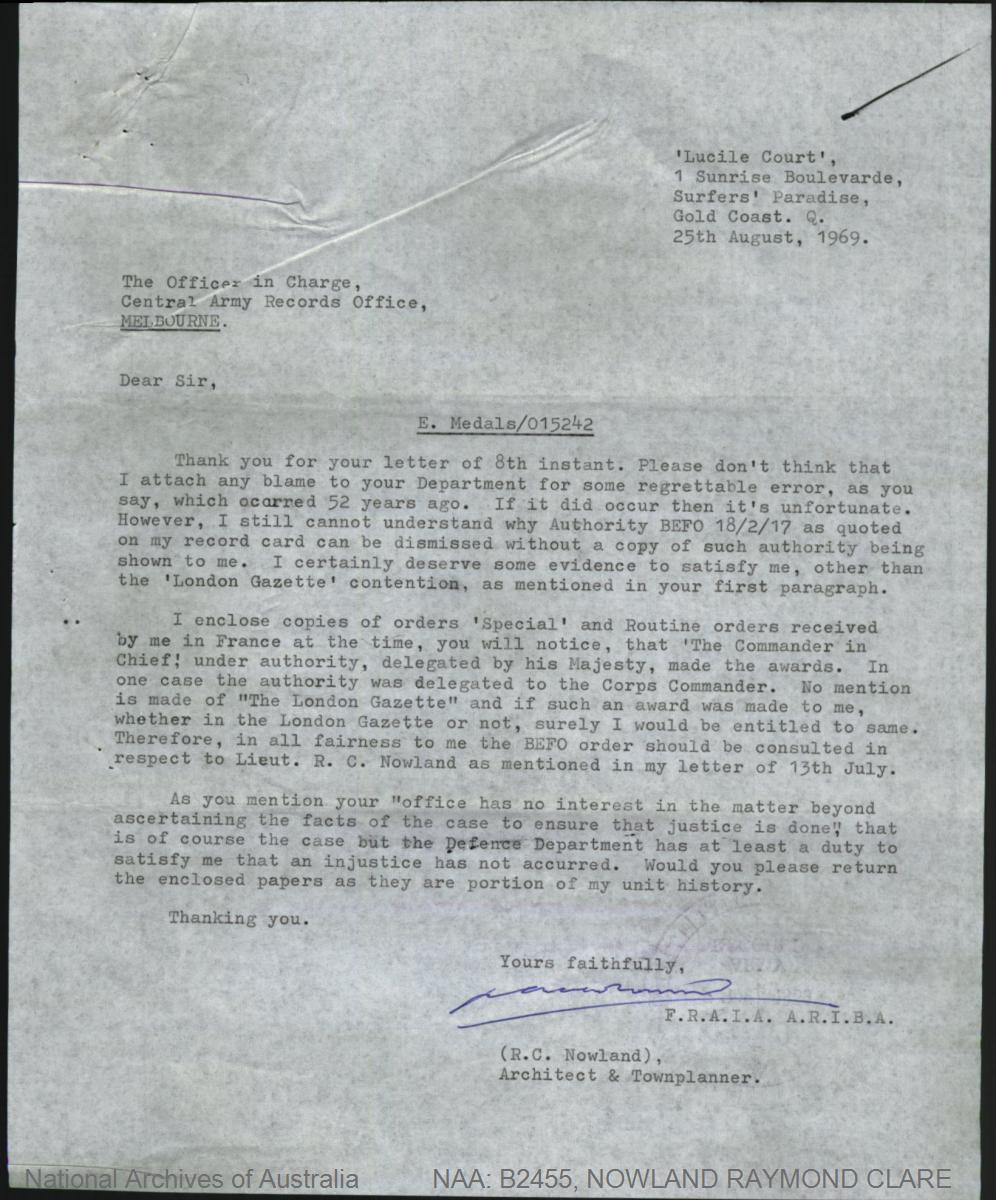

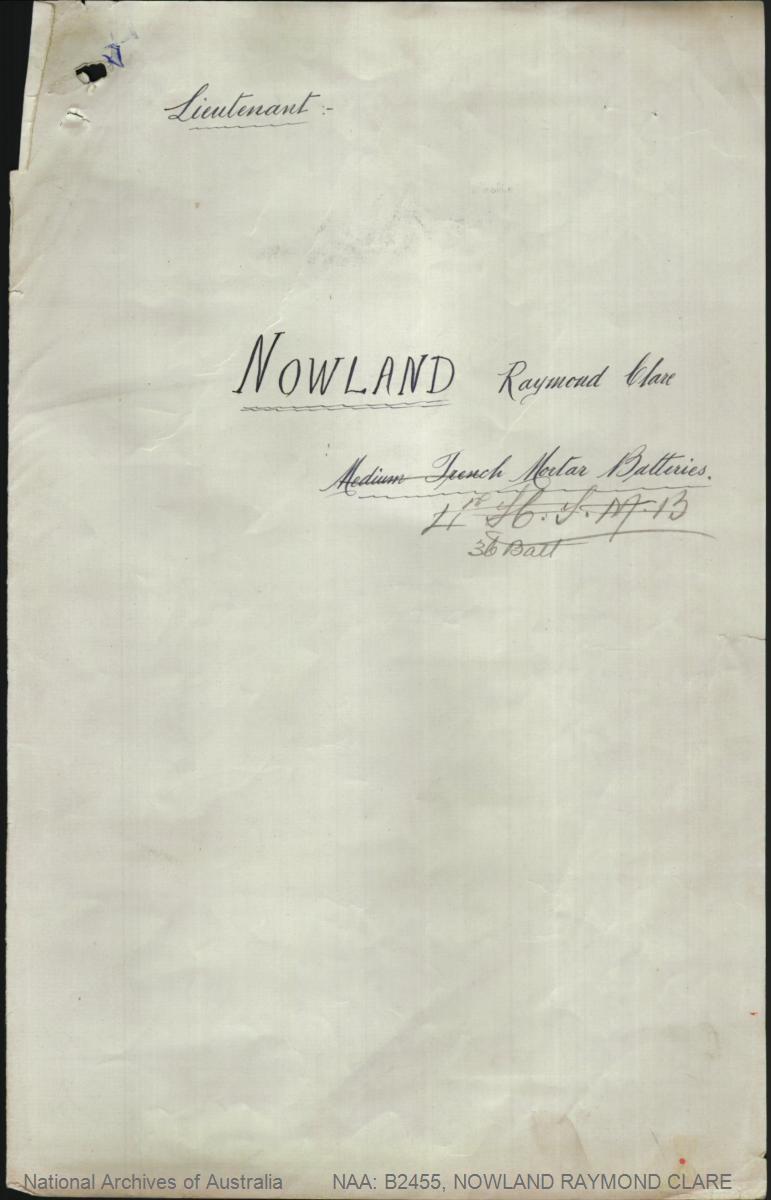

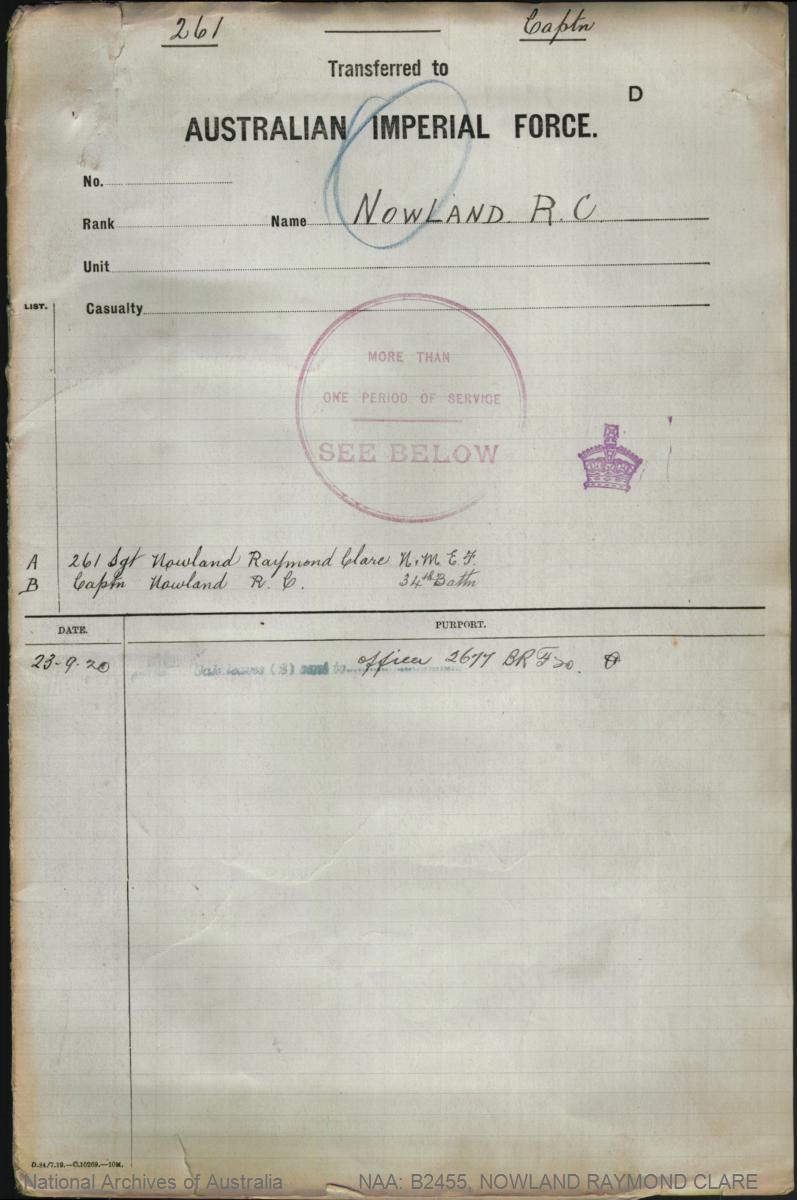
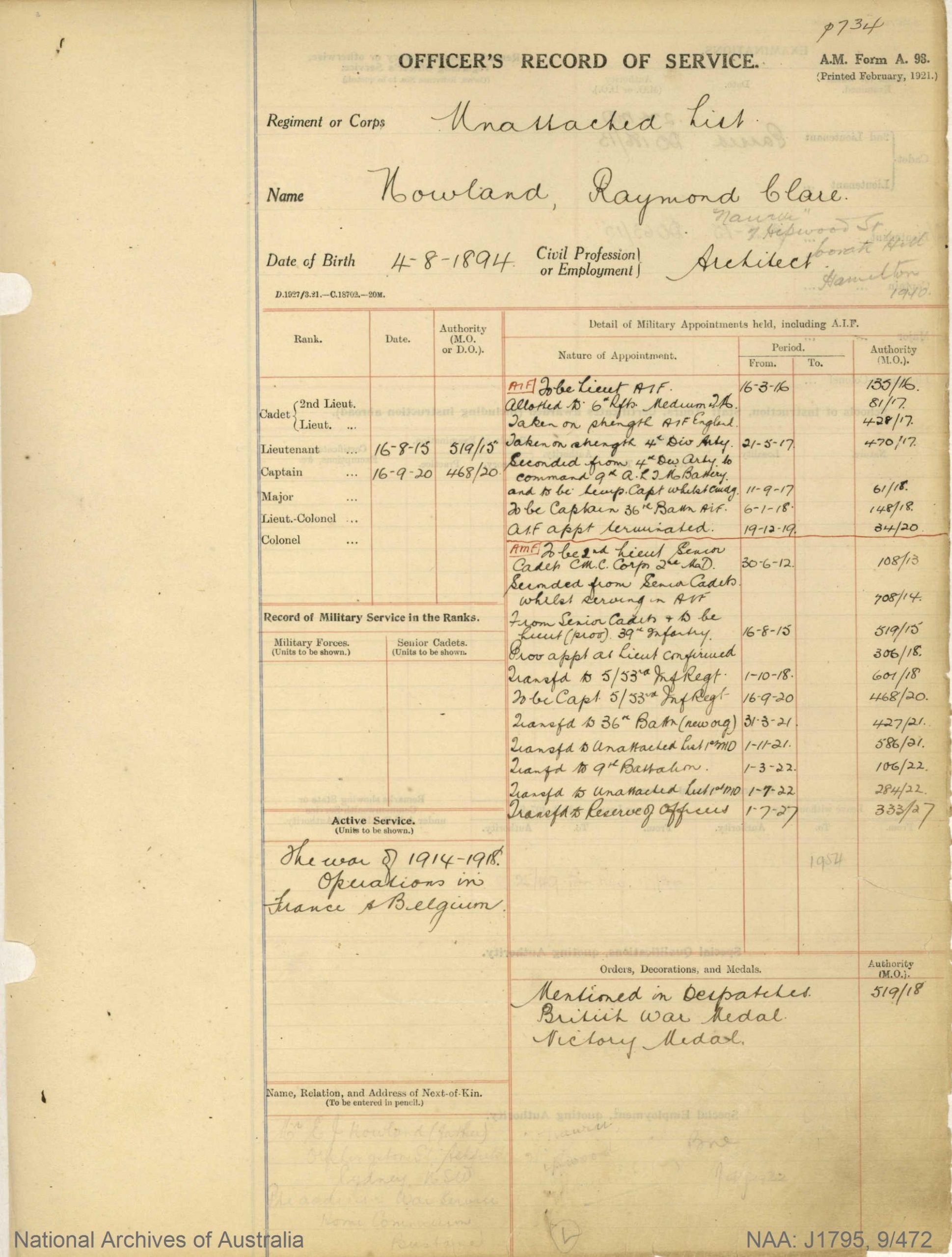

© Commonwealth of Australia (National Archives of Australia)
Under Construction: 19/07/2020-25/07/2020.
